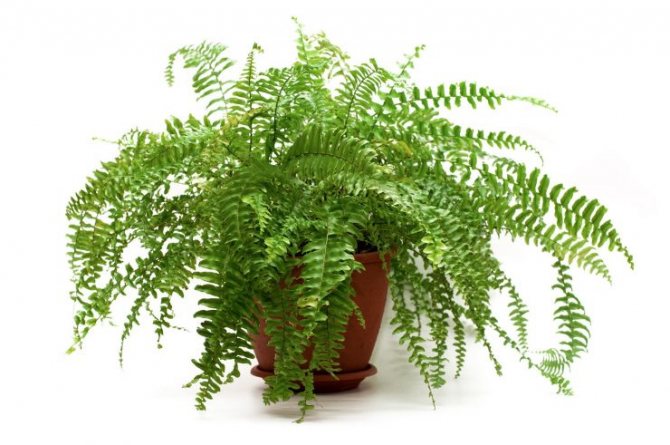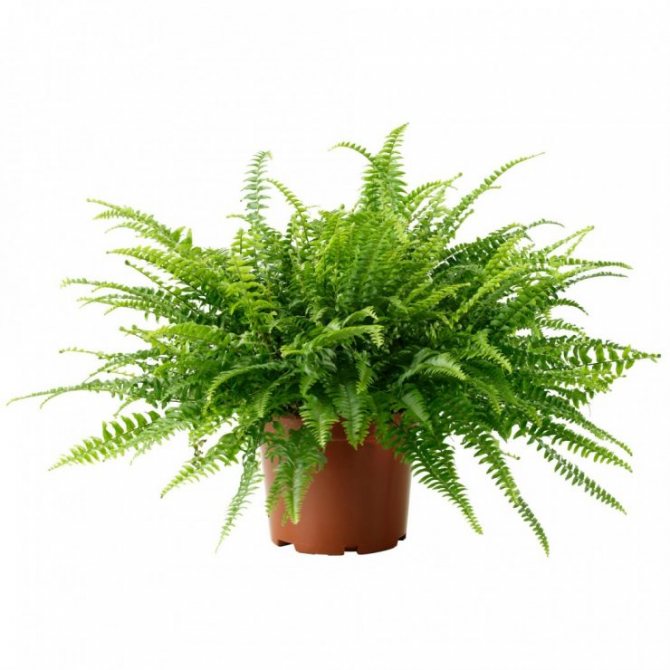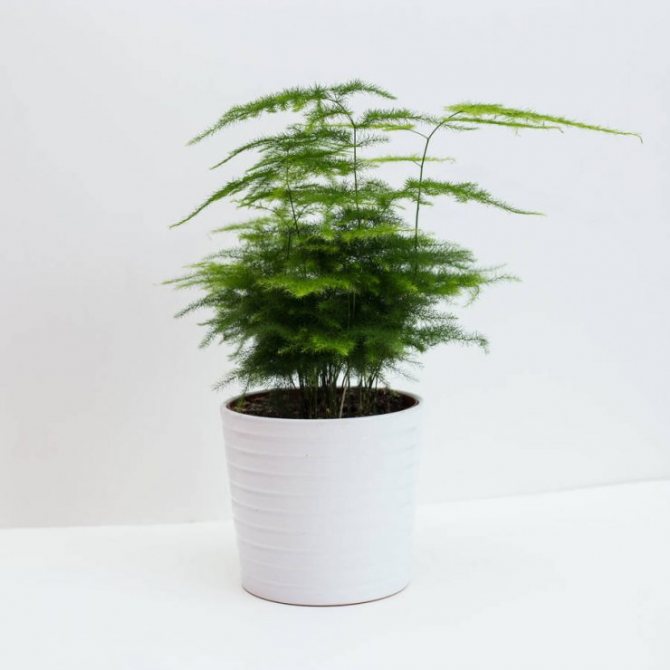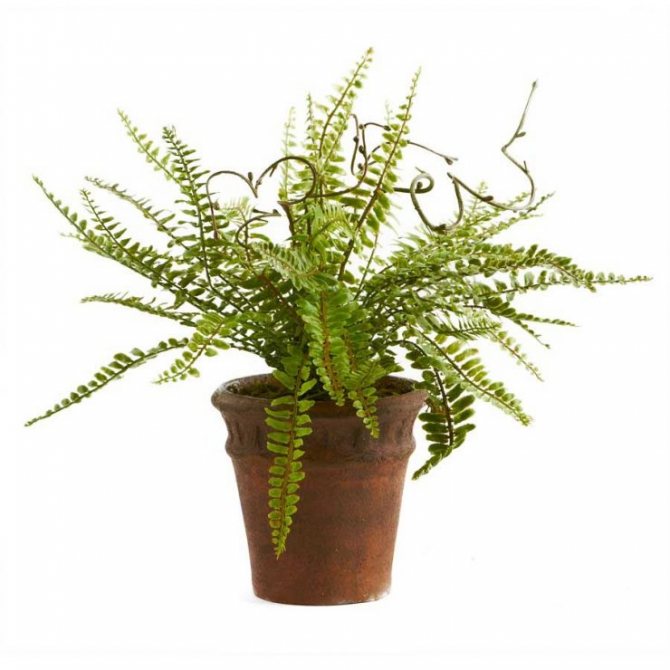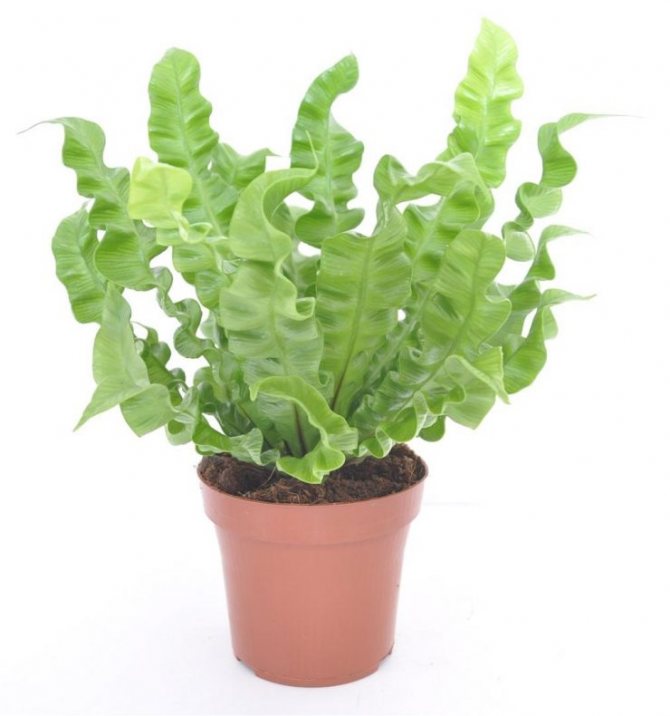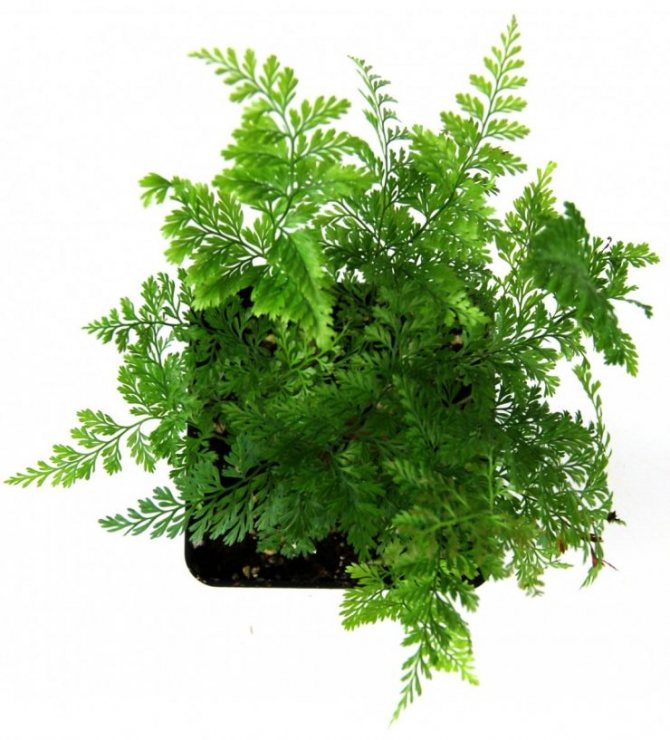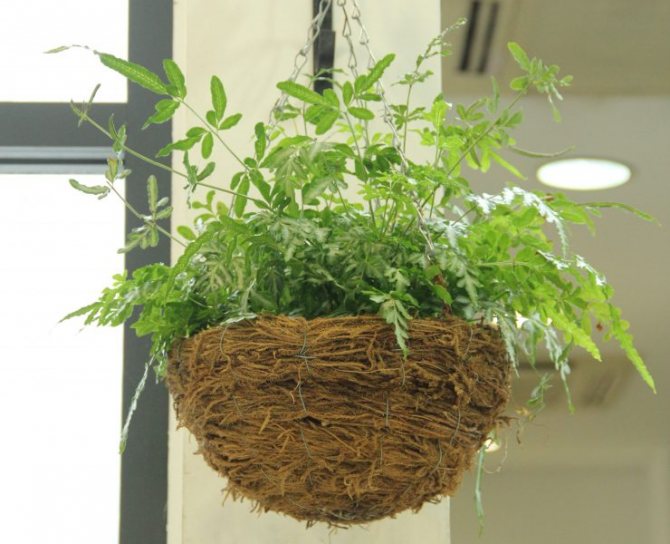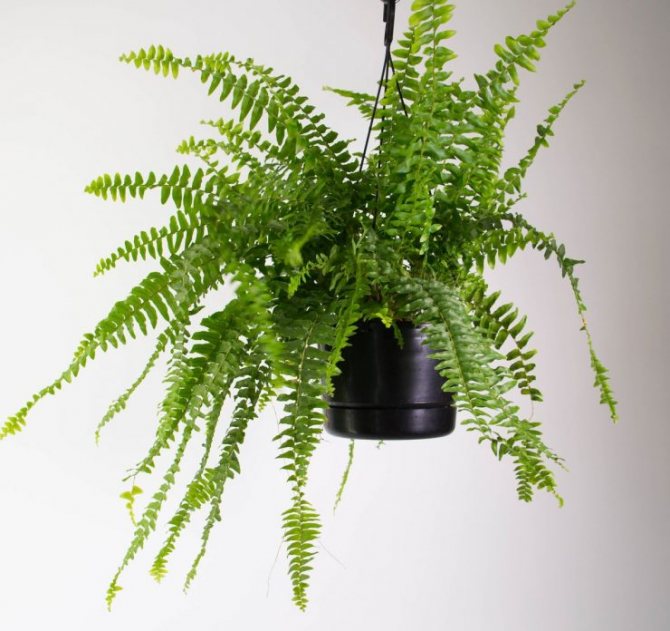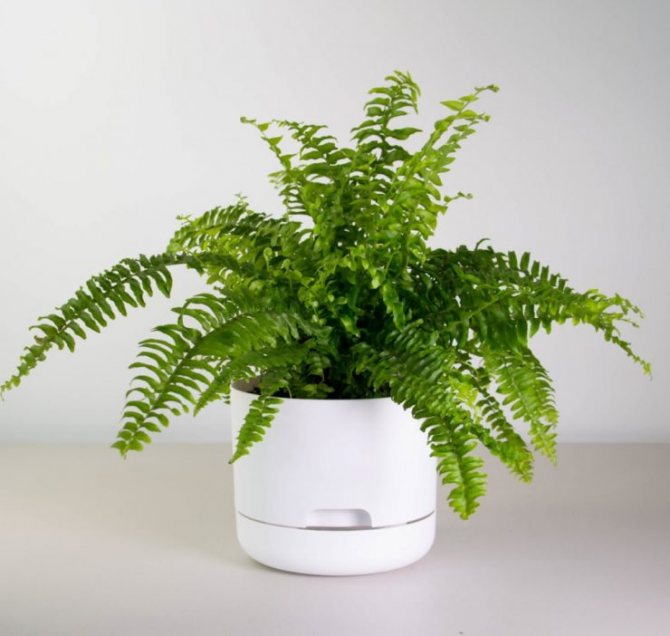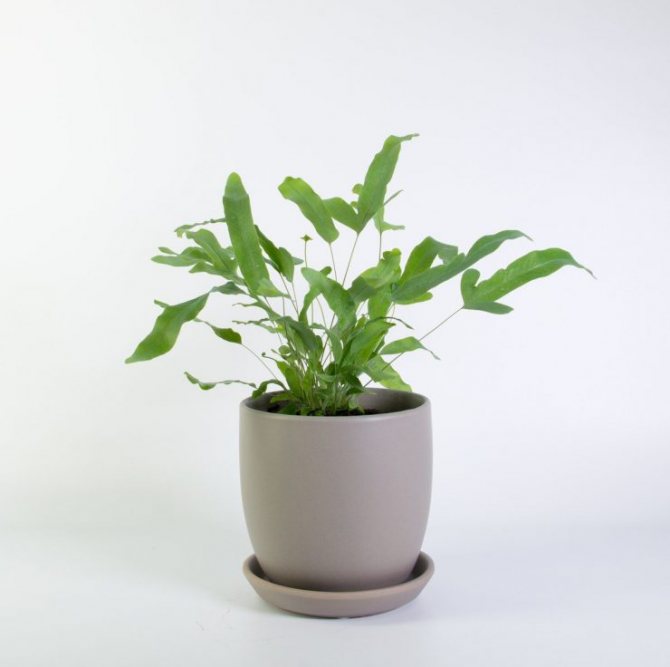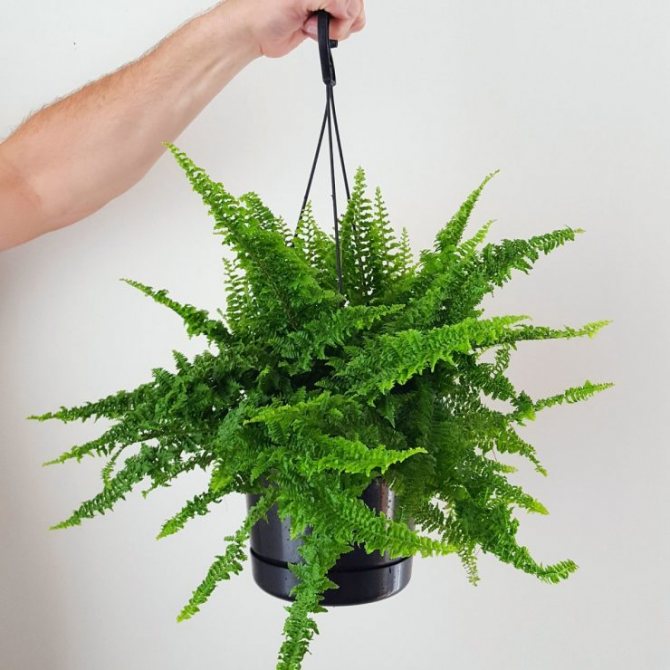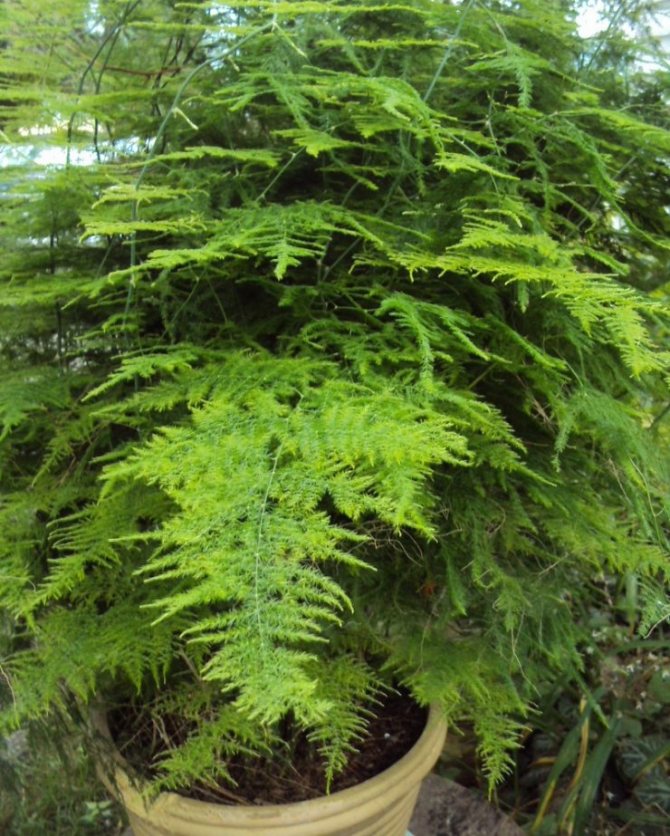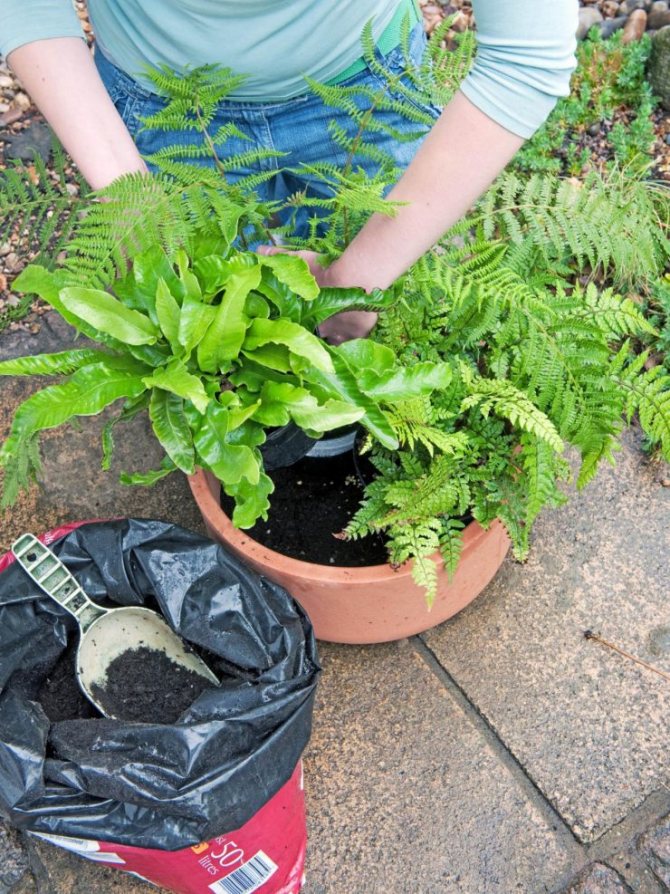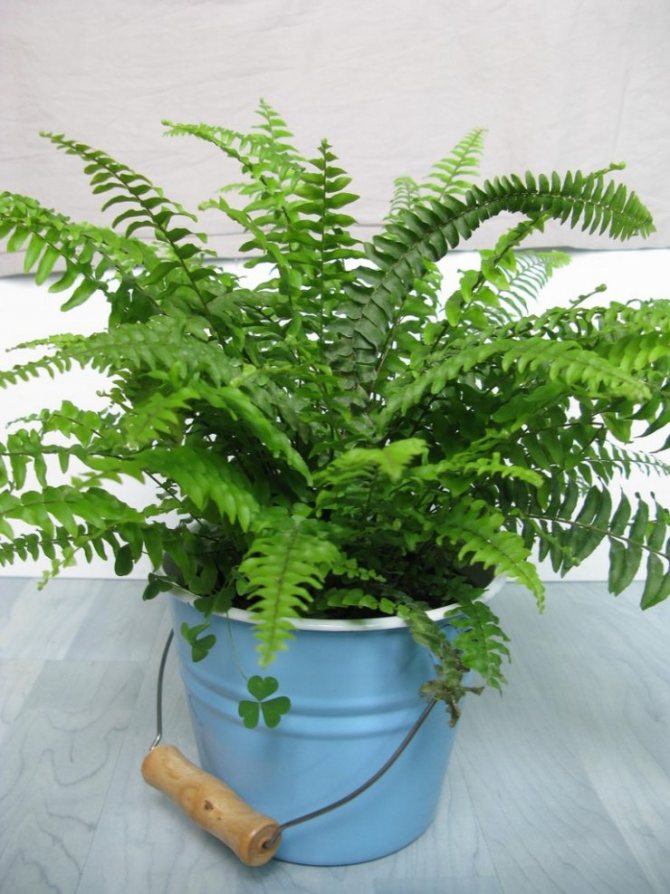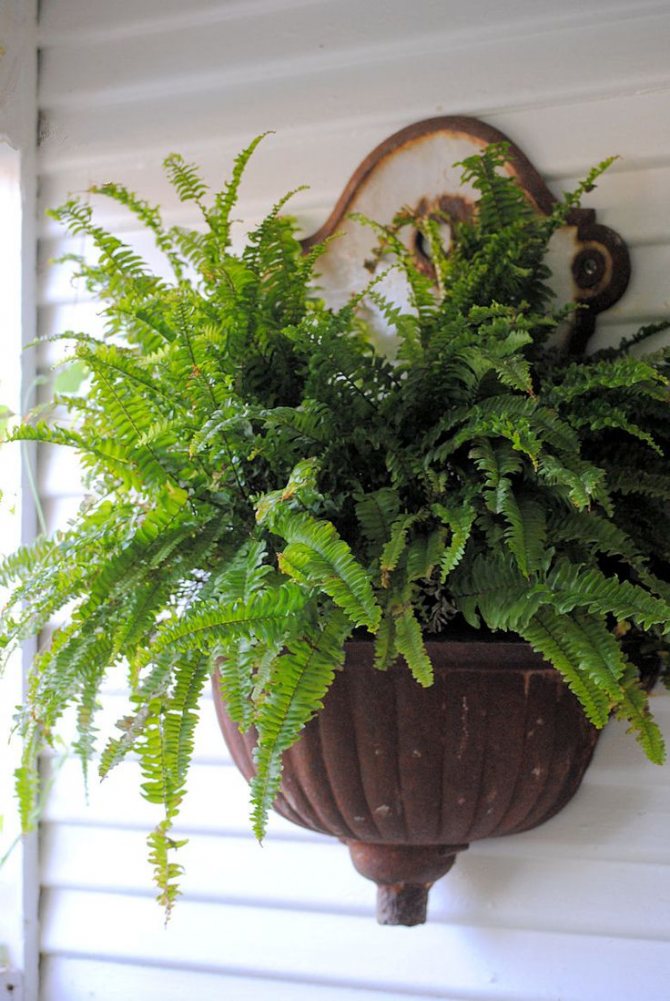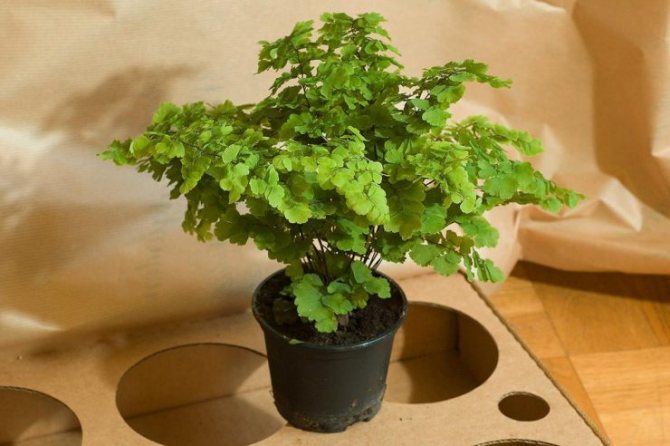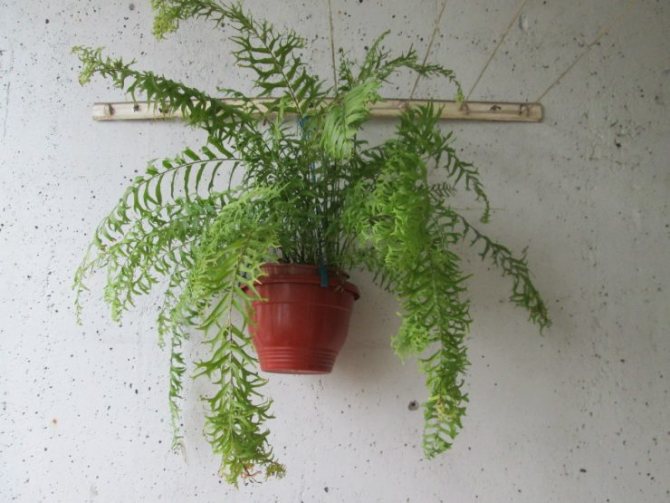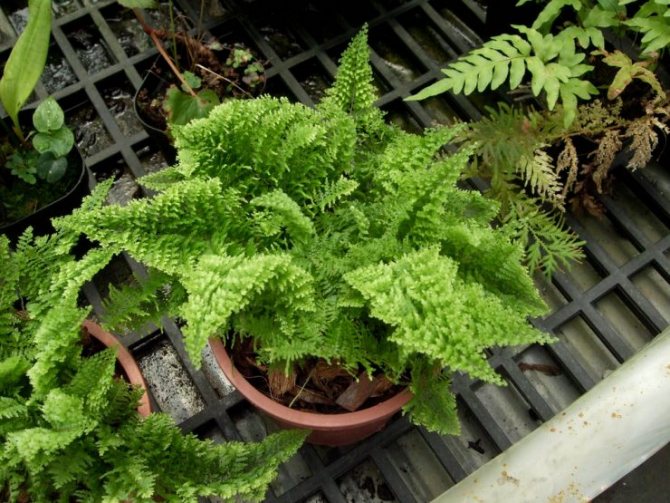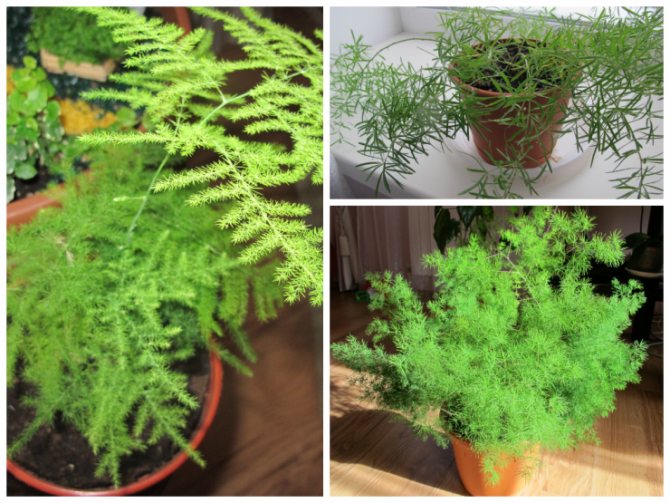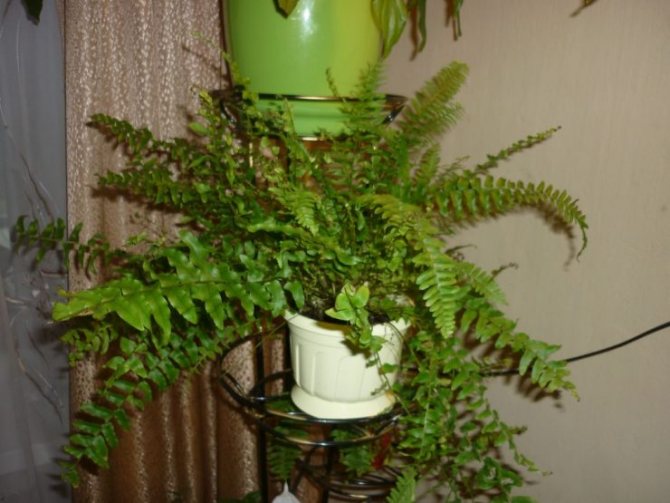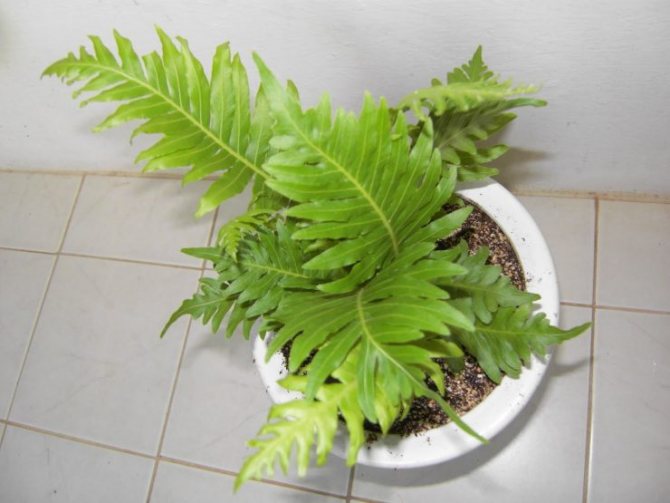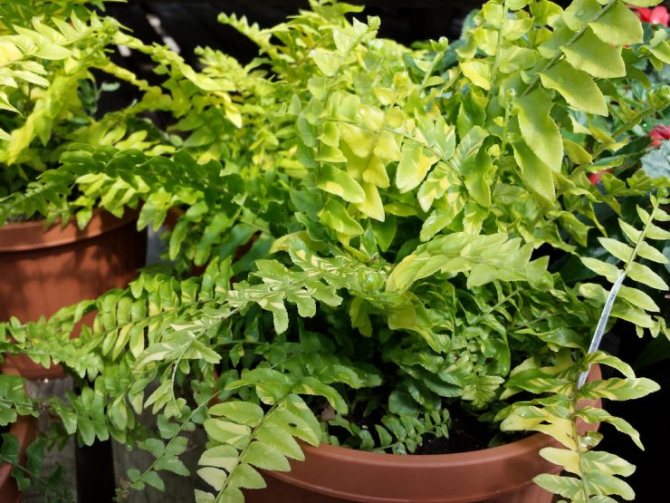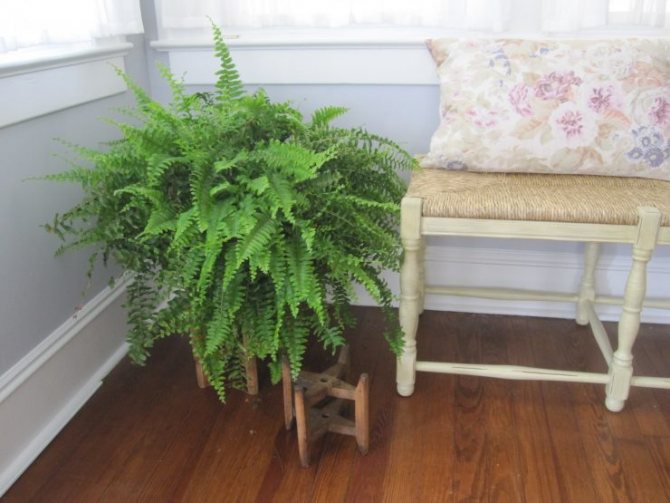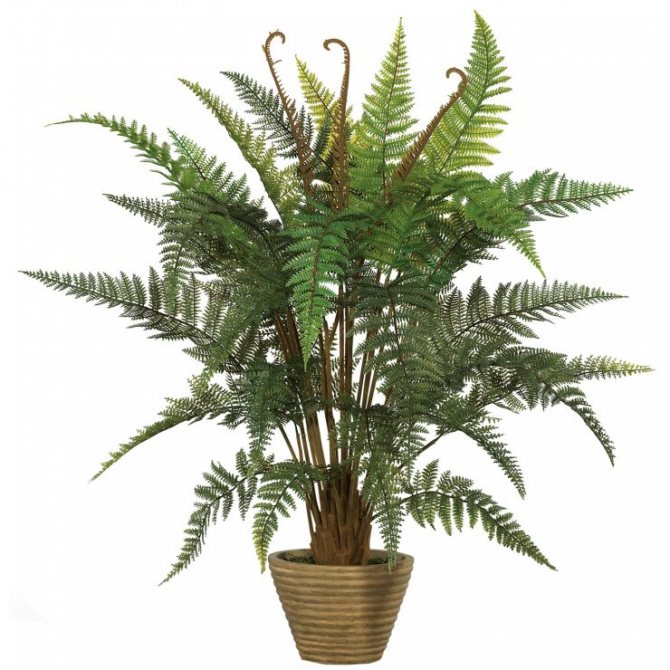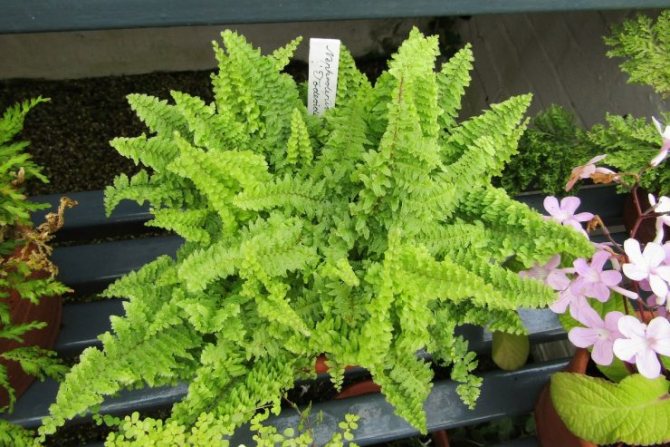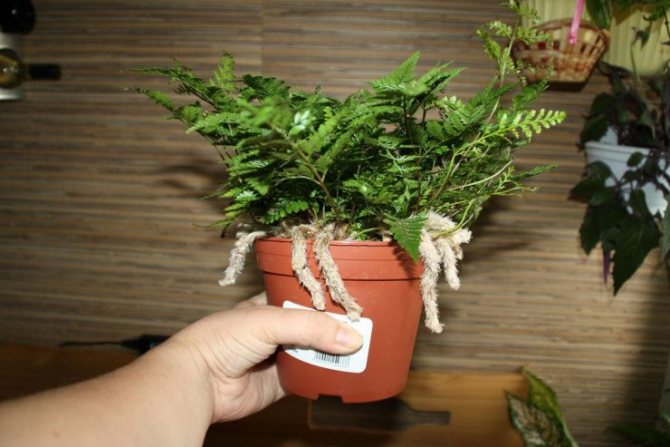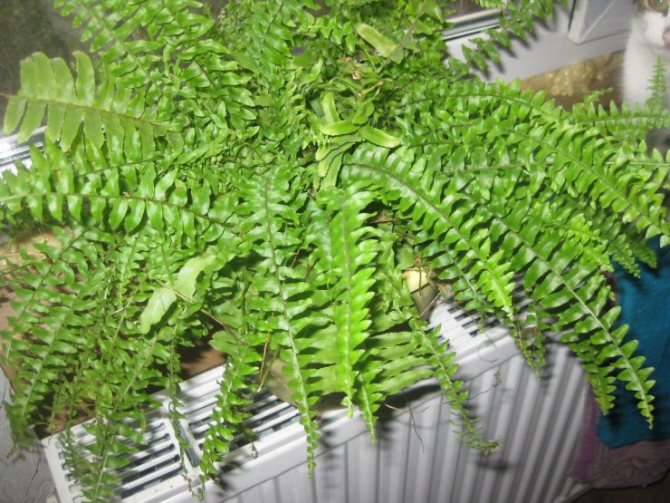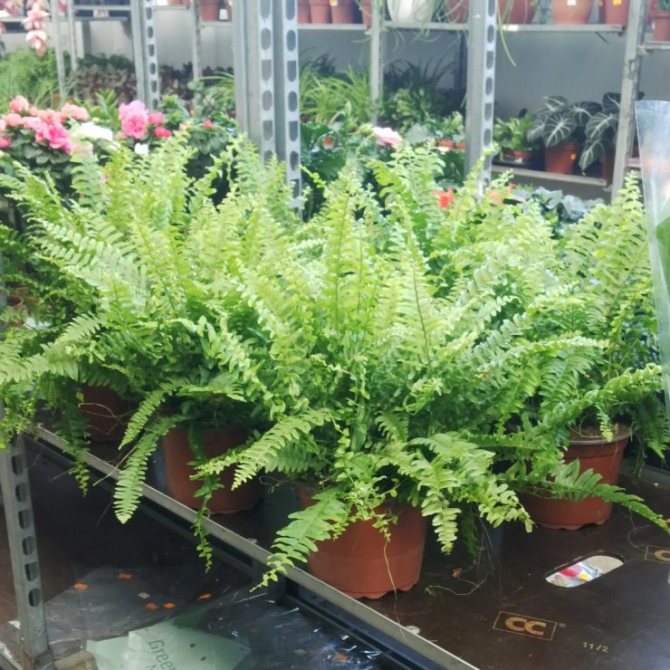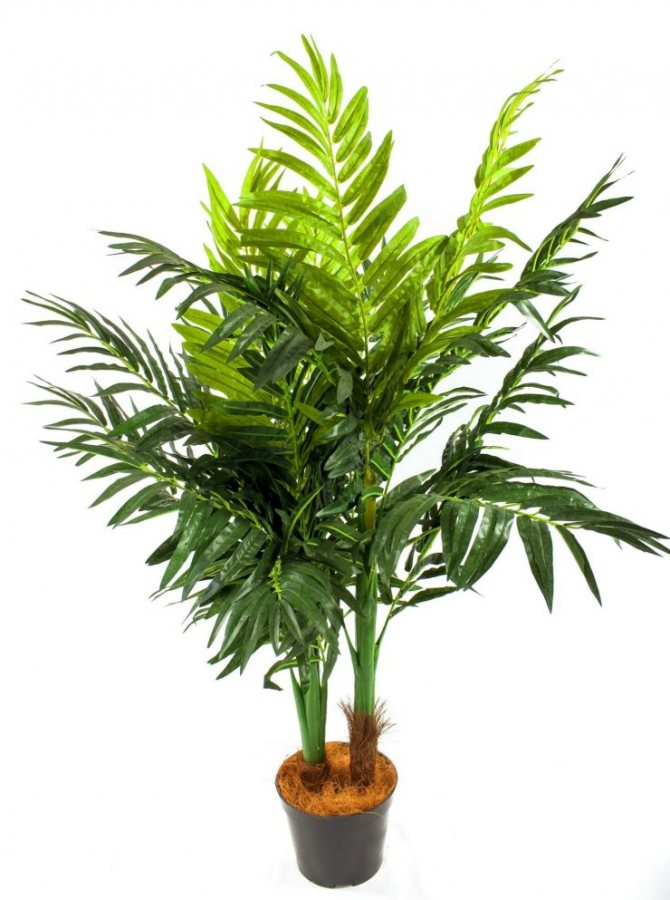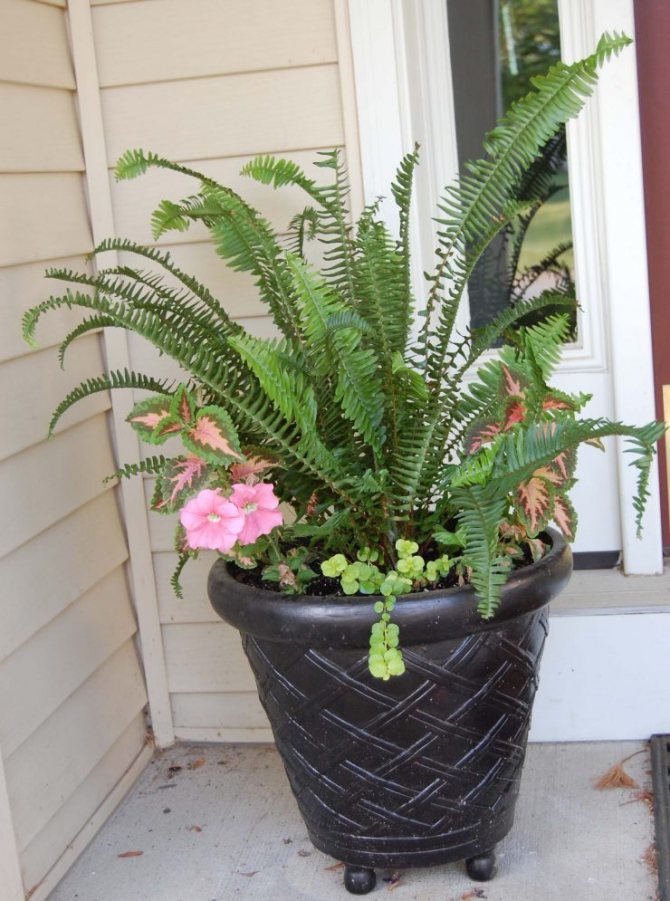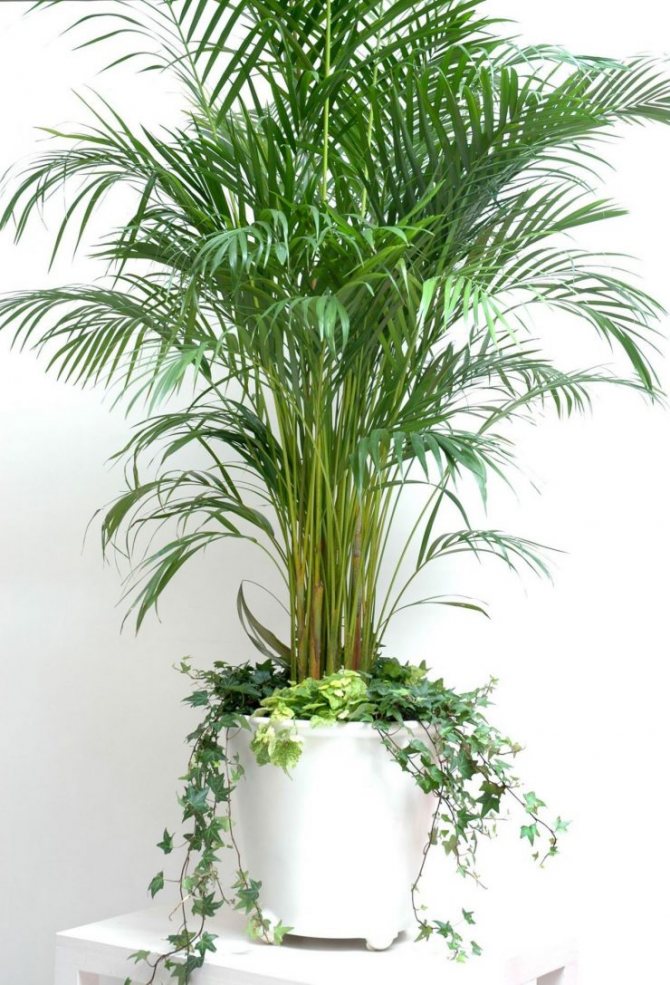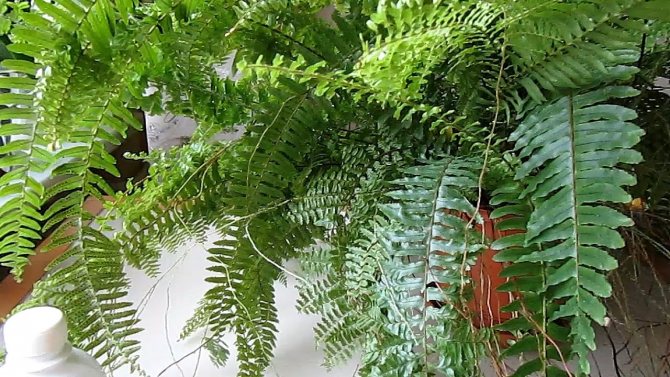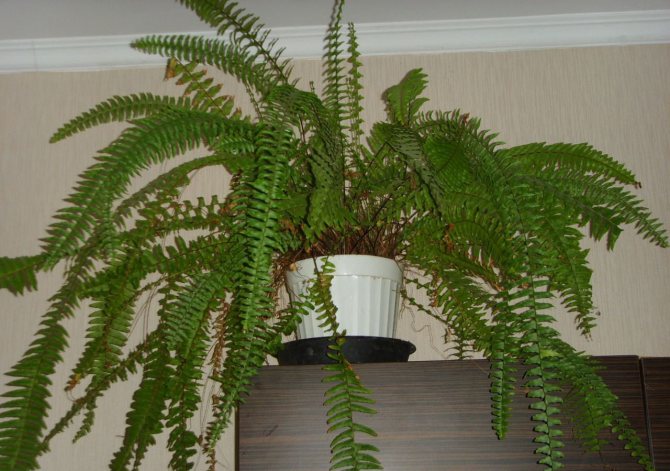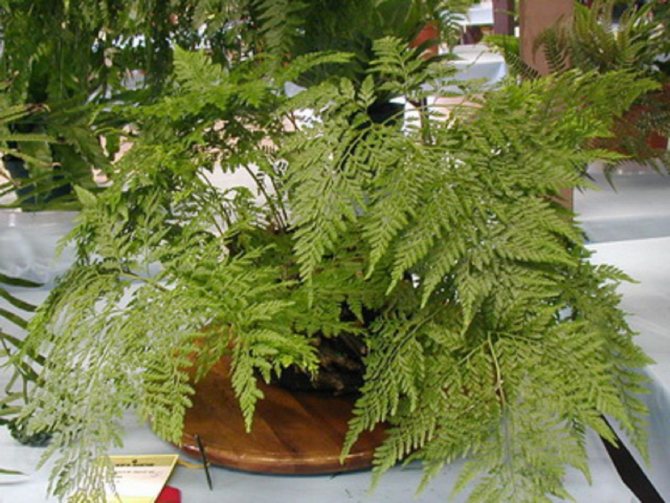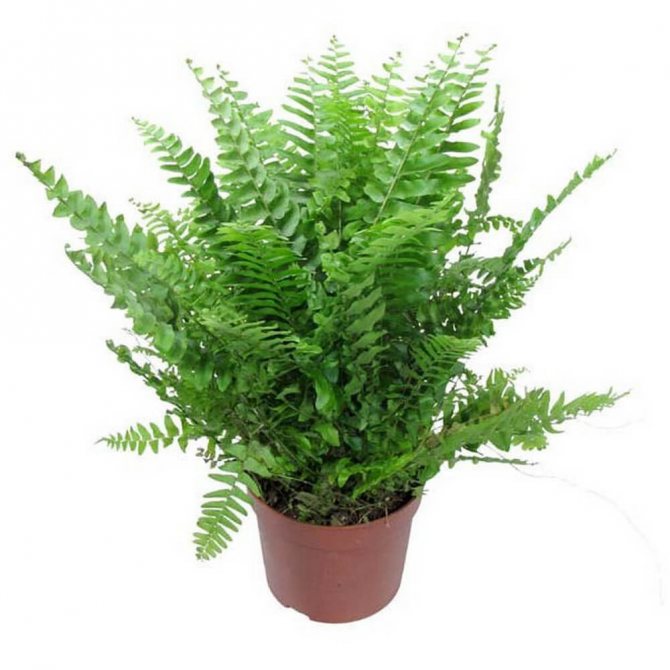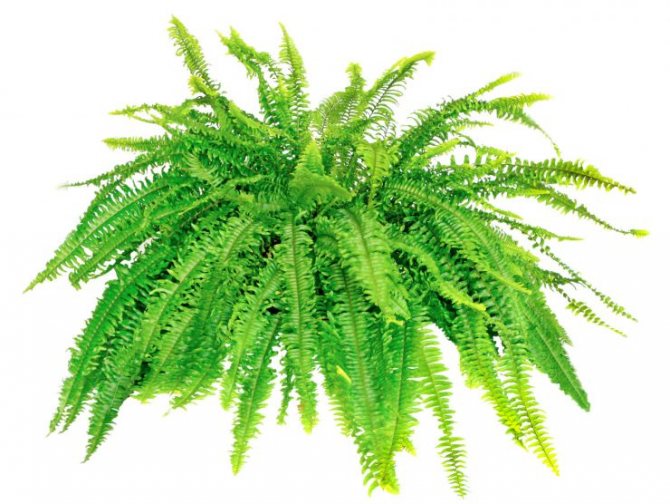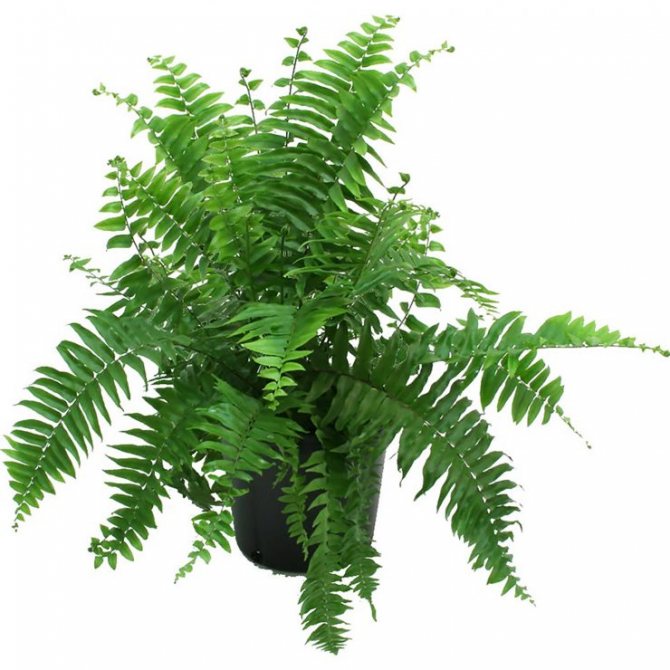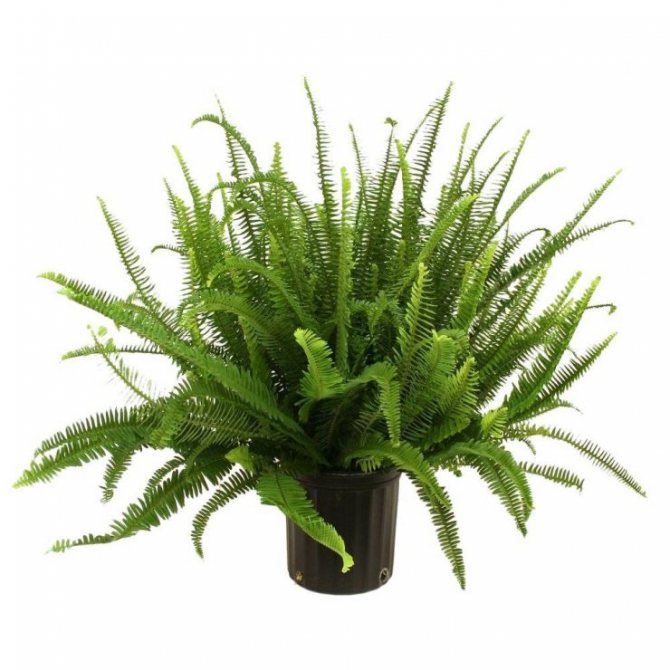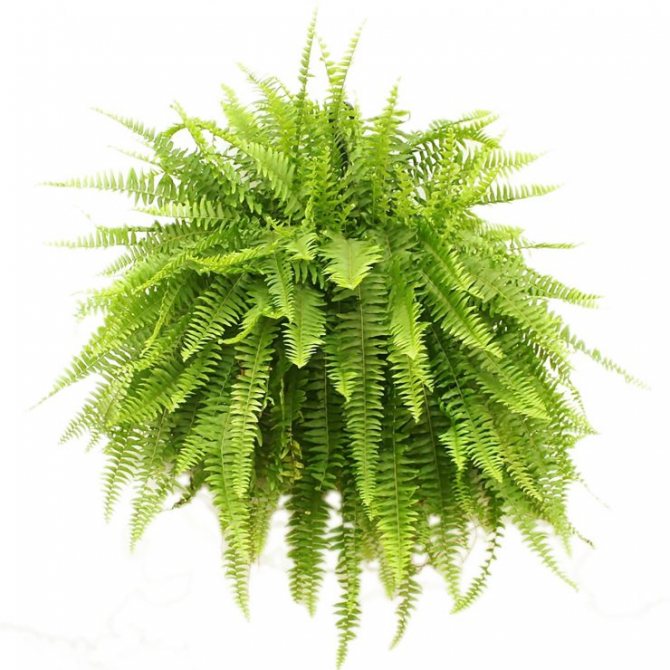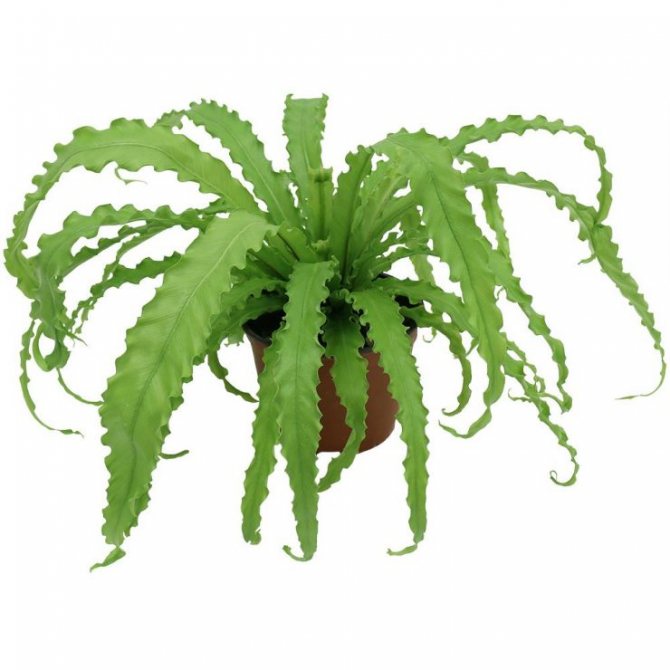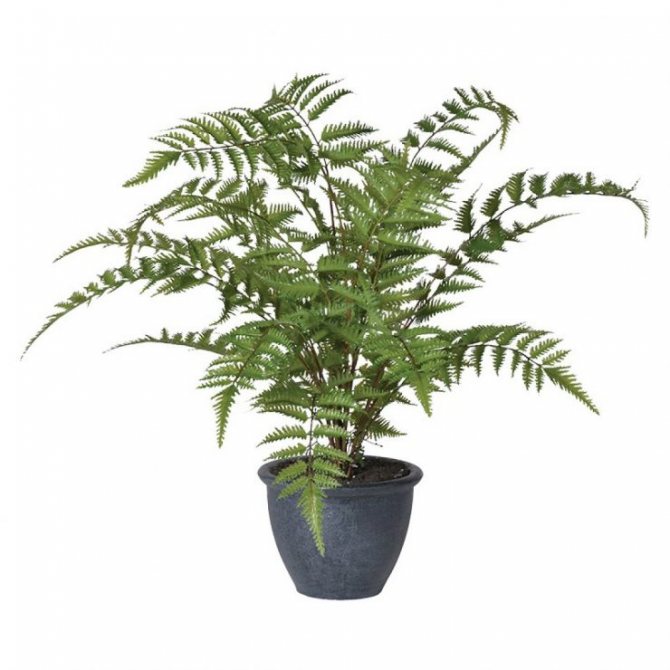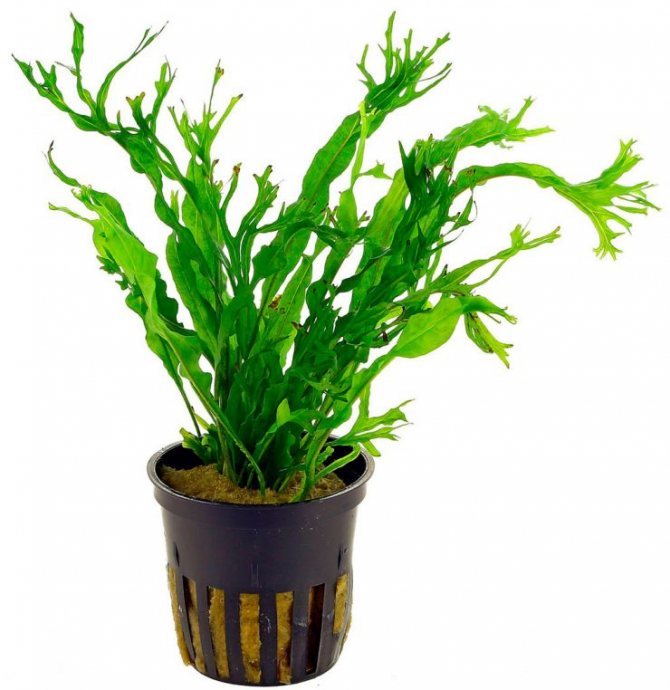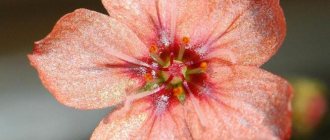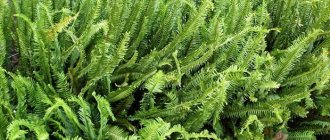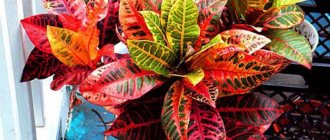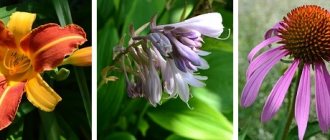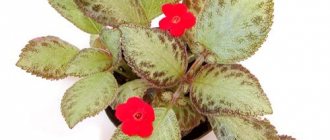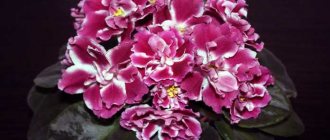Home ferns adorn many apartments and offices with their lush dark green foliage, are considered unpretentious plants that can withstand a long drought and lack of feeding. Impressive specimens look good in the foyer, on the veranda and on the terrace, smaller plants feel great on window sills and whatnots.
Indoor fern, home care for which is available even to beginners in floriculture, is able to revive the interior of any kitchen and living room, add rich colors to a boring room design.
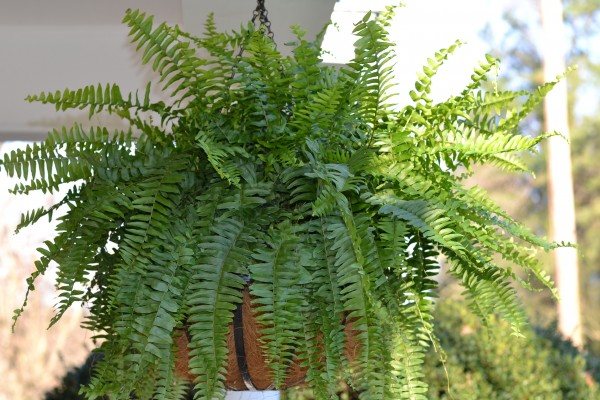
Features of the
Ferns grow in different climates, in meadows, swamps, forests. They may also be on trees, but most of them are found in the tropics. It is tropical species that are suitable for growing at home. There are also species that are resistant to frost. Gardeners willingly grow ferns in their backyards.
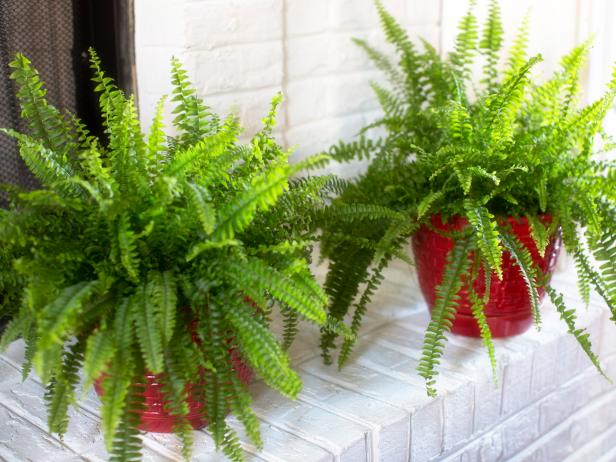

All varieties of plants include 2 parts: roots and openwork, feathery, curved leaves, which are called vayami. Many ferns have pinnately dissected leaves, but there are species with whole ones, differing in shape and size.
Plants reproduce by spores, as in fungi, mosses and algae. They are hardy in nature, but they may not survive in the house even with good care and proper conditions. Plants can determine the purity of the air: if they are in a polluted atmosphere, the leaves wither.
Legends of the blooming fern
What can chickens eat?
The most widespread legend says that on the night of Ivan Kupala (from 6 to 7 July) the fern blooms in a dense forest. The blooming fern appears exactly at midnight as a blooming ember. Moreover, at this time it opens with a crash, illuminates the glade with a wonderful color and makes an unusual sound.
A person who managed to master such a flower turns out to be subject to all secret knowledge. All the secret treasures in the earth can be accessible to him. But not everyone can get such a flower. It is located in the wilderness of the forest. To get to him, you need to overcome the fear of evil spirits that are gathering in the clearing. If a person is frightened or, even worse, looks back at the faces of the demons, then he will not see any flower.
This beautiful legend has some basis. There are very rare species of fern that throw out stems that look like bright flowers. But these are not flowers, but elongated and modified leaves with buds, which are called "sporangia".


Sporangia
Another belief says that at midnight a bud appears from a fern bush. It moves like a living bird. The movements come from the fact that the evil spirits are trying to hide the flower from the eyes of a person. It grows like a hot coal.
The Carpathian version of the legend has a similar narrative. In this region, there is a legend about the red flower - rue. Ruta has yellow flowers, but on the night of Ivan Kupala they suddenly change their color to red. This happens at night and the red color does not last long. If a girl managed, despite the fear of evil spirits, to look and pick such a flower, then she can bewitch any young man with her charms.This same flower will be a real proof of love and will look beautiful.
There are interesting recommendations on how to pluck the fern color. To do this, you need to go to the forest in the evening on the eve of the holiday of Ivan Kupala, find a fern and spread a sacred tablecloth around it. This is the name of the tablecloth, which was used during the Holy Week, before Easter. Around yourself you need to draw a circle with the help of a knife, consecrated also during the Holy Week. Next, you need to read the conspiracy and wait until midnight.
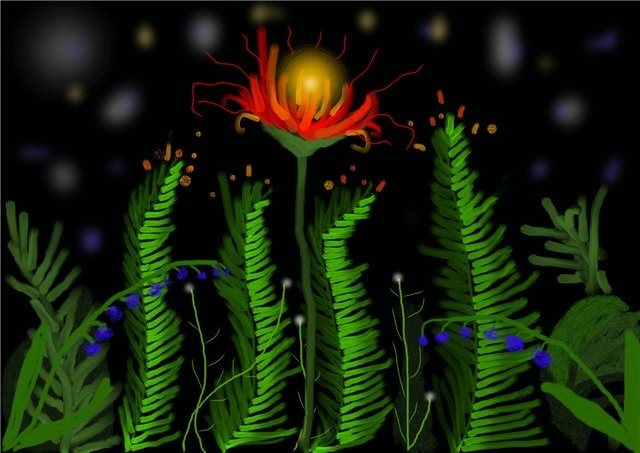

Fern flower
You need to wait for fern flowers with concentration and not be distracted by extraneous sounds, because evil spirits begin to yell, scream and whistle. Otherwise, the fern may not bloom. It is forbidden to be online. There is a belief that if you respond to the sounds of evil, when the plant begins to bloom, you can die, because evil spirits rip off their heads and send the soul straight to hell. Walking near the fern bloom should be very careful.
Interesting. Having picked a fern flower, you need to hide it in your bosom and quickly run home without looking back. The meaning of this belief is interesting: if you perform actions as needed, evil forces will not "stick" to a person.
Manifold
There are several types of indoor ferns that thrive at home:
- Maidenhair. This plant has thin, strong stems, graceful fronds. It prefers warmth, shade and moisture. It is desirable to grow this species in winter gardens and terrariums. Items: For Sake, Gentle, Fine-haired, Venus hair.
- Asplenium. This type of indoor fern loves to be in the shade and in humid air. At home, several species are bred that are not similar to each other. This is Nesting and Bulbiferous, Viviparous.
- Nephrolepis. The plant needs space. The fronds are dissected, which provides an original openwork effect. Nephrolepis Exalted is usually grown and care is very simple. Reproduction is carried out by dividing a large bush or offshoots.
- Blehnum. The crown is 1 meter in diameter, and the hard fronds are like a palm tree. Blehnum Humpbacked and Brazilian are usually grown.
- Davallia. The plant has thick rhizomes. Therefore, it is called hare or squirrel feet.
- Platizerium. The fern has large, showy leaves, like deer antlers.
- Disconia. An adult plant can be up to 3 meters long, so it is suitable for spacious rooms.
- Pellea. The plant prefers dry habitats. Round-leaved and Green pellets are in demand.
- Polypodium. The plant has heavily dissected leaves.
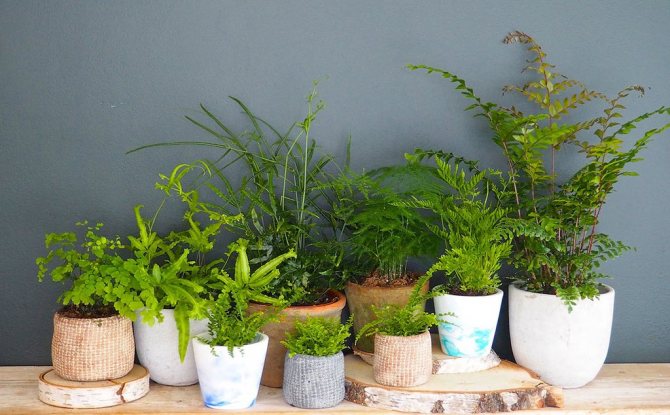

Large plants look original in hanging pots and on stands. Their feathery leaves are used to decorate bouquets. Plucked fronds recover quickly.
Description of the plant
Fern (Polypodiophyta) is an ancient plant with a multimillion-dollar history, numbering more than 300 genera and 10 thousand varieties. In apartment conditions, only a few of its varieties are grown:
- nephrolepis;
- maidenhair;
- polypodium;
- platizerium;
- pelley.
This lush indoor flower with a dense spherical or spreading crown consists of two parts: a not too powerful rhizome and feathery openwork leaves, scientifically called fronds. Arc-curved sheet plates differ in shape and size in different varieties, they are with dissected or solid sheets. There are no flowers and fruits in indoor ferns, but spores are successfully formed on the underside of the leaf.
Many owners of fern crops appreciate these plants for their healing properties and the ability to clean the air from dust. However, with a long stay in a dusty and dirty room, the fern begins to wither, it may even die. Another feature of an evergreen flower is the structure of its leaves.Young, unopened leaf plates grow tightly coiled into a spiral, then acquire a darker shade, become dense, and almost completely straighten.
It's important to know. Using the roots of the plant for the treatment of eczema, having abscessed, it must be remembered that the rhizomes are poisonous, and non-compliance with the recipe of the decoction can cause poisoning.
Care features
How to care for a fern at home? The plant needs regular watering and maintaining a comfortable humidity. Almost all fern species do not tolerate drought. Optimal temperature and lighting are important. It is necessary to correctly transplant and reproduce the fern. In the absence of competent content, he dies.
If the plant is near other house flowers, you should check that its openwork leaves are not squeezed. Vayi are fragile and need free space. Damaged and dry leaves should be removed in a timely manner, ensuring the free development of young shoots.
Fern soil
Before replanting a fern, you need to prepare the ground for replanting. Now there is no problem with this, such land is sold in flower shops. The main thing is that the earth should be with high acidity, it is also advisable to add sand, humus to the ground, it is advisable to add leafy earth. The land should be almost as natural.
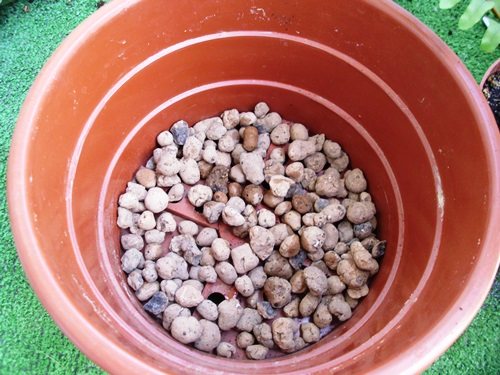

In the forest, the land is loose, with remnants of peat. It is desirable to bring the soil as close as possible to that in natural conditions. If the soil is not loose, the fern will not absorb water well, then the roots of your plant will begin to rot. If the ground does not allow air to pass through, the leaves will dry out and become covered with brown spots.
Watering
The plant loves water. A prolonged drought is ruining him. How often to water the fern? The procedures should be carried out after the top of the soil has dried.
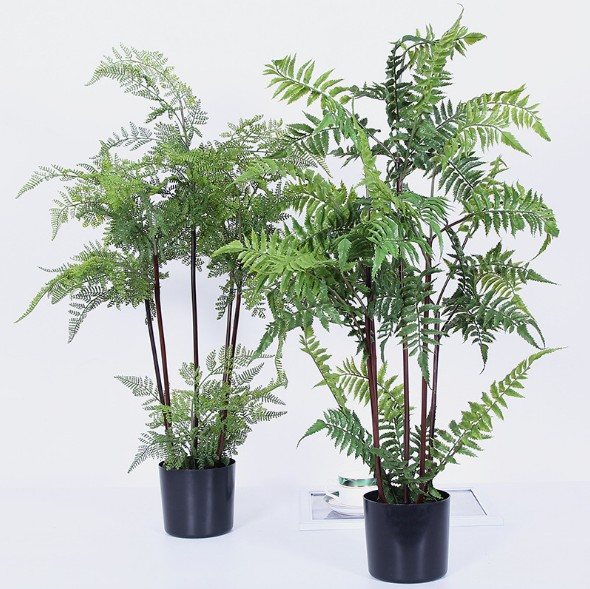

But excess moisture also negatively affects the root system, and can lead to the death of the plant. With strong moisture, yellow and brown spots appear on the leaves, the root will rot, and the plant dries up. It should be watered several times a week with settled water at room temperature.
Platizerium
A very interesting kind of fern - Platizerium, or Deer antlers (Platycerium). This is a rare plant, you can find it in greenhouses or among gardeners who are truly passionate about their work. In nature, a few representatives of this species live in Australia, India and some regions of Africa.
Platycerium, or Antlers (Platycerium).
Like many other ferns, Platycerium is an epiphytic plant and in nature can reach very large sizes. The smooth long fronds of the Platycerium, thanks to the original dissection, look like the antlers of a deer, for which they called him that.
The peculiarity of this fern is that it has two types of frond - some are long, up to 1 meter and smooth, while others have special depressions in the form of pockets. These bins accumulate moisture, insect remains, seeds of various plants and leaves. Over time, all this decays, and the resulting organic matter nourishes the plant.
Platiterium does not form spores and is bred only with lateral layers, which appear quite rarely. Most often, flower growers place deer antlers in hanging pots or attach to a snag. For pots, they make a soil mixture from bark, moss, branches or buy ready-made soil for orchids. If the antlers are grown on driftwood, then you need to provide the plant with the necessary air humidity, and when watering, immerse the driftwood in water so that it is saturated with moisture.
For more information on the types and cultivation of Platyceriums, read the article Platitzerium, or Plohorn - the most unusual of the ferns.
Temperature
How to care for a fern at home so that the plant does not die? It is necessary to ensure the optimum temperature.It is 15-22 degrees. But the specific mode is selected based on the type of plant.
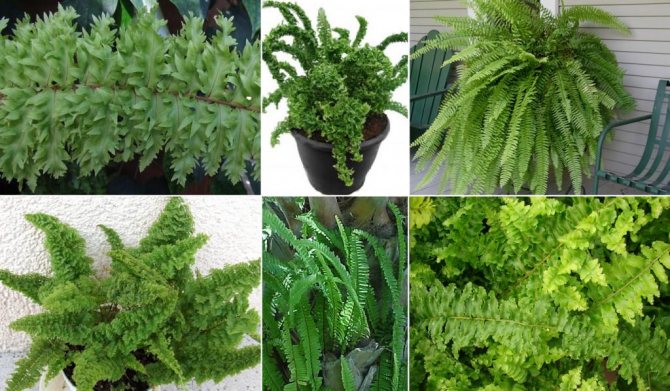

There is:
- Heat-loving. These include nephrolepis, asplenium, platycerium. In winter, the temperature should be at least 18 degrees.
- Resistant to low temperatures. This is a polypodium, pimpled, pellea. Plants can live when the temperature drops to 12 degrees.
Any kind of fern does not need drafts, but they thrive in the fresh air. The room where the flower is located should be regularly ventilated.
Types and varieties
Home gardeners have been successfully growing fern for many hundreds of years, during which time the appearance of the plant has practically not changed. In apartment conditions, the following species are bred.
- Nephrolepis. The most famous variety with a lush rosette of dense openwork leaves, covered with small spores on the underside. The length of leaf plates in an adult state usually reaches 40-50 cm.
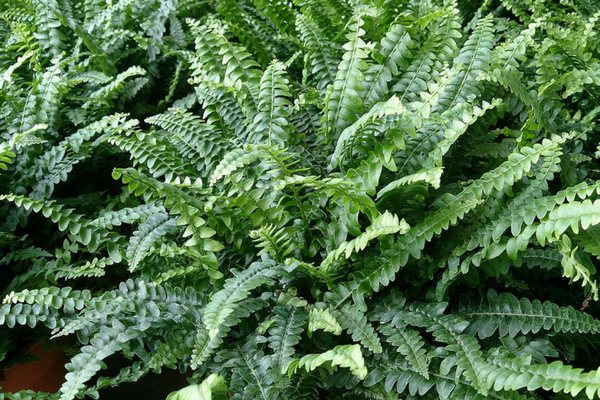

- Davallia. Among the people, the variety received another name - the hare's foot. The bush is distinguished by shaggy roots of a reddish color hanging from the pot on all sides, rich green leaves.
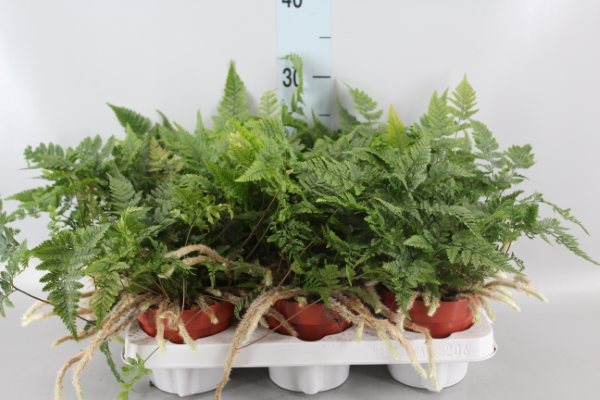

- Platizerium. This species has flat leaves sticking out in different directions, resembling a little deer antlers in shape. The dense center of the plant with brownish green leaves also resembles a cabbage head.
- Asplenium. The second name is Kostenets. This is a variety of domestic fern with unseparated leaves, slightly wavy at the edges. The flower does not like touch and frequent rearrangements.
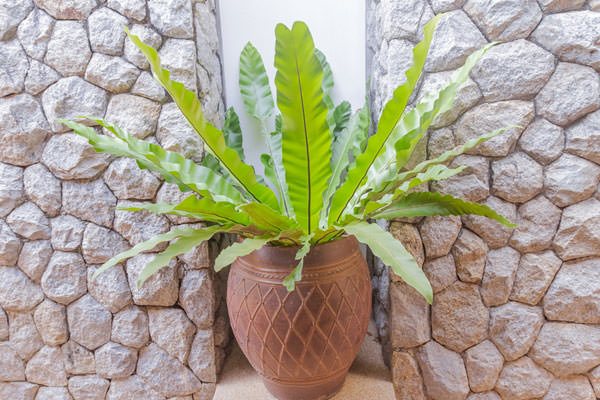

- Blehnum (Derbyanka). It resembles a little palm tree, grows up to a meter in diameter, has frond very hard to the touch.
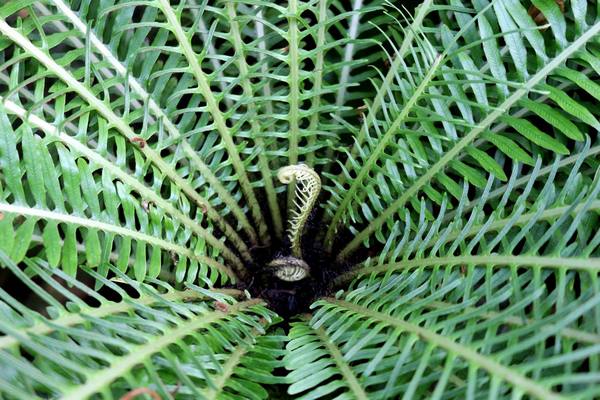

- Polypodium. Popularly called the millipede, it is distinguished by strongly dissected leaves growing on thin stems. The rhizome spreads over the soil surface, and the bush itself can grow by hanging in the air.
All ferns are quite unpretentious and not capricious, they can withstand temperature drops and a long absence of watering, however, they have a beautiful bush shape only with regular care.
Soil preparation
The soil for indoor fern should be loose, air and water permeable. Stagnant moisture causes root rot. It is desirable that there are many rotted leaves in the soil, slightly less needles and peat.
Fern needs a soil with slightly increased acidity (pH is 5.0-6.6). The parameter is easily set using a litmus test. The soil (2 g) must be mixed with distilled water (10 ml). The mixture is shaken, and let it stand a little. Then in the liquid above the sediment, you need to lower the litmus paper. At pH = 5 it will be yellow, and at 6 it will be greenish-yellow.
Choice of place and conditions of detention
In caring for an indoor fern, a florist does not have to look for expensive indoor fertilizers, an unusual soil composition or ceramic pots of an original shape. It will be enough to occasionally feed the flower, water it periodically, observing simple requirements for temperature, illumination and location. What conditions must be met so that the fern grows healthy, fluffy, does not dry out and remains green all year round?
- Lighting and location. Too bright rays of the sun are harmful for the fern, cause burns, so in spring and summer the flower needs a little shading. In a strong shade, the flower will grow, but its decorative effect will significantly suffer from the lack of diffused light. The best placement option is not on the windowsill, but not far from the southwestern window, placing the pot on a table, whatnot.
- Temperature. Most ferns are native to the tropics, so they love warm and humid air. In summer, the plant grows comfortably at temperatures up to 28-30 ° C; it is not recommended to allow long overheating in bright sun. You can even take the pots out into the garden or on the open terrace by hanging large specimens in the pots on hooks.In the fall, you will have to bring all the pots into the house so as not to destroy the plants. In winter, it is advisable to reduce the room temperature to 17-18 ° C When the thermometer drops below 10 ° C, the heat of the rhizomes may overcool and rot.
- Air and humidity. A plant in the heat requires not only abundant watering, but also frequent irrigation of foliage from a spray bottle with filtered water. Plain, from the tap, will leave unsightly white spots on the fronds. It will not be superfluous to place a container of water next to the pot to humidify the air and wipe the leaves in some varieties with a damp sponge. You can also spread sphagnum moss moistened with water on the soil surface, purchase an air humidifier. You also need to watch that the indoor flower is protected from drafts at any time of the year, and in the summer from strong gusts of wind when grown outdoors.
- Soil and pot. All ferns prefer loose soil with the addition of humus and a handful of rotted leaves. The presence of spruce needles and peat in the soil is not prohibited. The ground should be airy so that the water flows well when irrigated to the roots. It is imperative to have a drainage from expanded clay or pebbles at the bottom of the flowerpot. The soil mixture is easy to purchase in the garden center, but you can do it yourself by mixing turf, peat, leafy soil from the garden in equal proportions. Mixing a small amount of river sand and humus is not prohibited. It is recommended to plant small specimens in sturdy clay pots or inexpensive plastic containers of any shape with a diameter 2-2.5 times smaller than a fluffy crown.
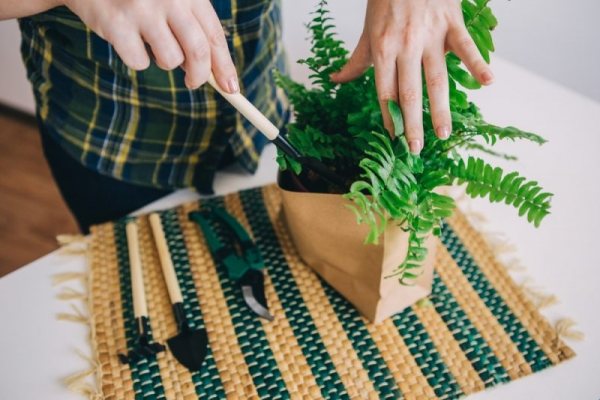

Fertilizer
Fern feeding is optional, as it feels fine without it. If they become pale and shallow, then this indicates a lack of nutrients in the soil.
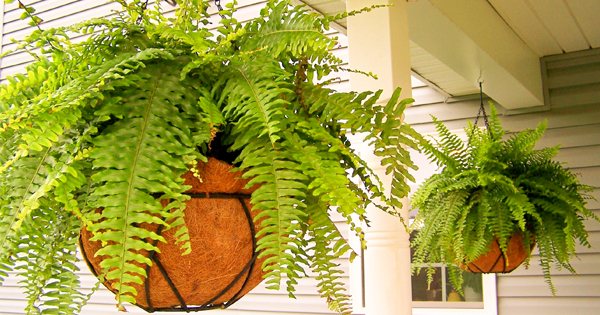

The plant needs feeding during the period of active growth - in late spring and summer. Fertilizers should preferably be performed using liquid complex mineral compositions, for example, a solution, 1 liter of which includes:
- potassium salt - 1 g;
- superphosphate - 1.5 g;
- ammonium nitrate - 1.5 g
Carefully you need to use organic matter, as it can cause burns. Some growers periodically add tea leaves to the pot or water it with a weakly infused drink.
Nephrolepis
The most common genus of ferns in nature Nephrolepis (Nephrolepis). About 30 species of this plant grow everywhere, and you can find them in the most unexpected places. Unpretentiousness, resistance to various diseases and pests were appreciated by flower growers in many countries of the world, and certain types of nephrolepis migrated to the premises.
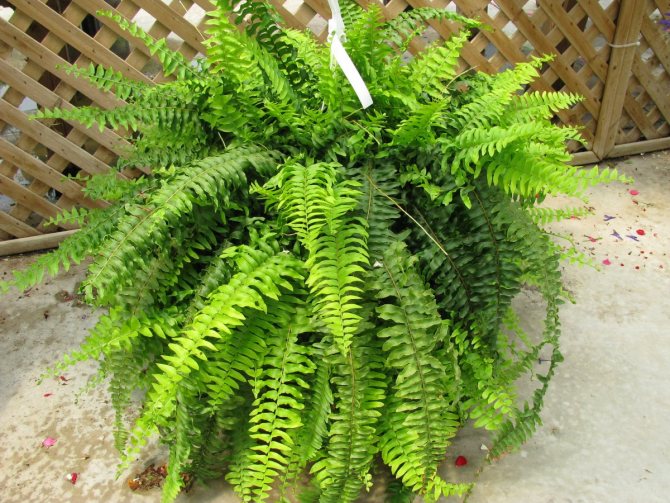

Nephrolepis (Nephrolepis).
One of the most popular potted ferns is Nephrolepis sublime... This species is quite often found in houses, as it is the most unpretentious among its fellows. Nephrolepis frond reaches 70 cm in length and, thanks to numerous dissections, resemble exotic feathers of a soft green color.
If the fern is kept in suitable conditions, and ideally for it - diffused light, warmth and high air humidity, then it will certainly become the center of attention in the apartment - numerous bright slightly curved fronds will not leave anyone indifferent.
Nephrolepis Boston - A close relative of the Exalted Nephrolepis. It differs from its relative only in the shape of the leaf blades, which, twisting, give the whole plant a curly and very decorative look.
Nephrolepis Heart-shaped differs in erect fronds with delicate rounded leaves. Branches of this type look very original and are often used to create bouquets and all kinds of flower arrangements. However, other types of ferns are also used for these purposes.
All types of nephrolepis reproduce easily and do not pose any particular problems when growing. They can reproduce both by spores that form on the underside of the leaf plate and by offspring that appear on short ground rhizomes.
An adult plant is propagated by dividing the rhizome, while the fern should have several growth points. Their number will determine how many divisions will be obtained as a result of the operation. Reproduction by spores does not always bring results, since they do not fully ripen in indoor plants. Therefore, this method is rarely used by flower growers.
Read more about growing nephrolepis in the article Nephrolepis - unpretentious and elegant.
Transplant features
This plant is fast-growing, so at a young age it needs to be replanted annually. And adult species - every 2-3 years. The procedure is performed in the spring.
How to plant indoor fern? In order not to harm the plant, a large pot is needed. Indoor fern transplant is performed by transshipment method. With this procedure, do not deepen the base of the rosette of leaves into the ground.
It is not worth cleaning the soil from the roots of the flower in order to exclude damage to the fragile roots. An exception is indoor flower disease, in which it is required to identify damaged roots and remove them.
For transplantation, you should purchase a soil substrate with an acidic environment or prepare the soil with your own hands. This will require:
- land - 1 part;
- humus - 1;
- peat - 1;
- bone meal - ½ part.
Timely transplanting ensures the normal development of the plant. It must be done carefully and without haste.
Indoor fern: reproduction and transplantation at home
It is quite simple to propagate indoor fern, this process is a bit like propagating a flower. Female happiness in that the root system must be divided and then transplanted into a new pot.
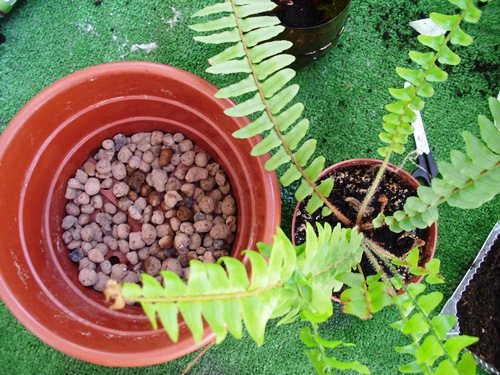

Water the plant well before transplanting, then take a larger pot and transfer the flower to a new pot. Such a transplant will keep the roots of nephrolepis from damage.
You can repot the fern every year. Transplanting is done mainly for the reason that the roots grow and become cramped in a small pot. If you reload your fern in the fall, the plant may get sick and will have to recover for several months, so the beginning of spring is the best time to reload.
If you want not just to transplant, but also to propagate nephrolepis, then this is not a difficult process. To reproduce during transplanting, you need to pull the bush out of the pot, after which you will see young basal rosettes. They need to be very carefully separated from the parent bush so as not to damage both the adult plant and small children. Then you put the kids in a separate container.
In order for a young bush to take root faster, it needs to create greenhouse conditions. Take a plastic or film cover and cover the container with the transplanted fern with it, this will facilitate and speed up the survival of the young plant, since there will be enough heat and moisture under the plastic or film.
In order for your new plants to take root well, create all the necessary conditions for them and provide proper care. The air must be humid, the soil must not be overdried. If you do not adhere to these simple rules, then your children will most likely die.
Capacity
Looking for shallow wide flower pots. Mediums are fine for a start, but it is important that they fit the size of the root system. In too large a container, the plant often gets sick, and in a small one it stops developing.
As you grow, you will need to transplant into larger flower pots. It is important that the container is round, without bent edges, since it will be easier to transfer the soil tuber during transplantation.
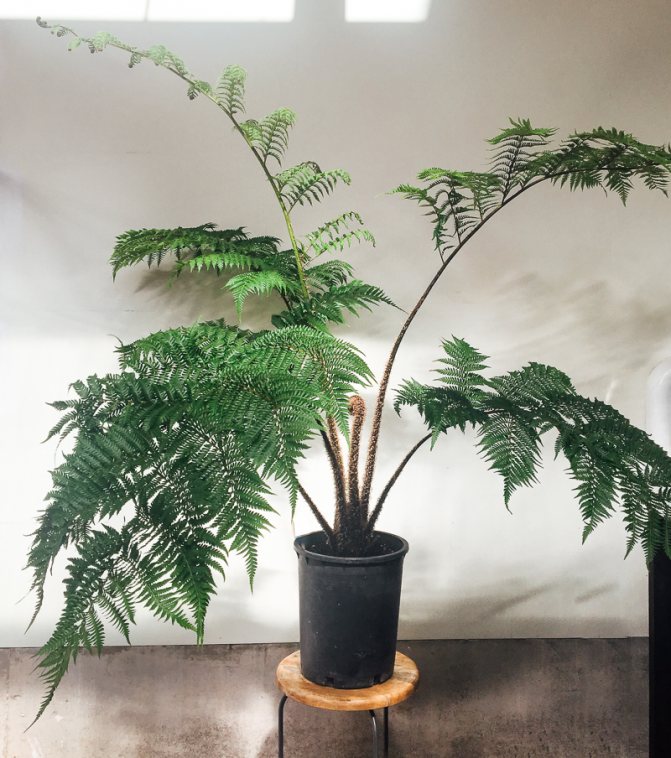

For growing flowers, experts recommend using clay pots that allow the roots to "breathe" and do not emit components that are toxic to humans. You should not worry about external unaestheticness, the container will be covered with dense foliage. Clay pots are massive and stable, so they can hold a flower. Their disadvantage is that microbes and pathogenic fungi can enter the root system with air.
What ready-made soil can be purchased in stores
Now on store shelves you can find various types of soil for indoor plants. They indicate acidity, ingredients, composition.
Knowing which soil composition is favorable for nephrolepis, you can find a suitable one in specialized stores, with a recommended acidity of 5-6.6 ph.
Biohumus in various variations and leaf humus are added to the purchased soil for succulents (peat, sand, minerals).
But in any case, this soil should not contain:
For young bushes, the soil should be shallower, softer, looser. To create such an effect, expanded clay, foam crumbs, and ground pumice in small proportions are added to the pot.
There are several popular methods for self-preparation and soil preparation.
Leafy soil is mixed with verticulite, expanded clay, greenhouse and turf soil, coarse sand in a ratio of 2: 1: 1: 1: 1.
Mix in equal proportions of humus, peat and leafy soil. Peat, humus, leafy soil are mixed in equal proportions and a little bone meal is added to the resulting mixture, about 1/5 part.


Heavy clay soils cannot be used, since nephrolepis will not be able to fully receive useful substances and liquid, it will start to hurt, and the root system will rot in such an environment.
Reproduction
How to grow a fern at home? Plant propagation is performed using:
- dividing the bush;
- dispute.
The second option is difficult and time consuming. Therefore, even professional florists rarely use it. The brown dots on the bottom of the leaf are the spores that propagate the plant.
At home, ferns are propagated by division. This requires young root rosettes. They should be separated carefully so as not to harm the plant. It is advisable to perform division on a cold, cloudy day.
How to take care of a plant that has been planted not so long ago? It is imperative to provide a suitable air humidity (about 70%) and abundant watering for 2 months. Dry air and soil in the pot can damage the fern.
Interesting properties of the fern
What can chickens eat?
In popular belief, this plant has magical properties. Since time immemorial, it has been used not only for magical rites, but also for the treatment of many diseases:
- With the help of a flower obtained at midnight in front of Ivan Kupala, you can find treasures.
- To attract the groom, the girl weaves a branch of a fern into her braids and wears it like that.
- To get rid of pain during sciatica, you need to fill the mattress with fern leaves and branches. The medicine says that pain and inflammation will go away quickly.
- The root of this plant is used in magic against the evil eye. For this, the crushed part of the root is added to various potions. Anyone who drinks such a decoction will get rid of diseases caused by the "evil eye". It can protect you from disease. The root helps with love spell and lapel, removes the effect of any ritual to which the person did not agree.
- If you place a whole fern root above the house, it will protect the inhabitants of the house from negative energy. A sorcerer and any person with evil intentions cannot enter such a dwelling.
- To use the fern as a reliable remedy for the evil eye, you should wear it as close to your body as possible. To do this, the fern is dug up at dawn, washed, put in the sun to dry.It must be applied the next day.
- The root is used from gypsies. The plant helps to maintain clarity of thought and will not allow a person to deceive himself when communicating with her.
Some peoples use the fern for pickling. Prepared products with fern added to the brine have very interesting taste.
A fern is a plant that never blooms due to the peculiarities of its structure. Of course, there are people who still believe that at midnight before the holiday in a dark and dense forest you can find a magic flower, and that the plant can bloom. Many secrets and beliefs are associated with the plant, each of which is beautiful and unique in its own way.
Difficulties
If the fern is not properly cared for, it will hurt. The following pests often appear:
- Nematode. Appears when watered with cold water with chlorine. The leaves will be yellow and dry. The only way to escape is to transplant into a new pot, which is treated with insecticides in advance. But the treatment is not always successful, sometimes the fern dies.
- Scabbard, thrips, aphids. They usually grow on ferns in a room where the air is too dry. Regular spraying and a warm shower allow preventing damage to the flower. If pests still appear, the plant must be treated with insecticides.
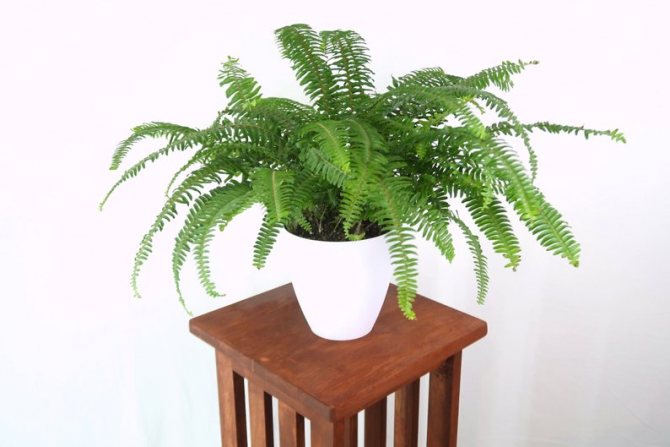

Diseases and pests are not all problems that growers face. Plants are sensitive to inappropriate living conditions, which is why they become yellowed, dry. Ferns dry out due to:
- low or high temperature (more than 25 degrees);
- using cold water;
- watering with a liquid in which there is a lot of chlorine;
- dry air, the presence of heating devices near the flower;
- exposure to direct sunlight;
- growing in a cramped pot or lack of nutrients in the soil.
Therefore, it is important to provide suitable conditions for the plant. Even minor violations can cause these problems.
Indoor Fern - Environmental Inspector
Indoor ferns, like their wild relatives, are considered unpretentious plants. But, nevertheless, not in all conditions they will grow well and look attractive. In the forest, ferns thrive on sandy, and especially peaty soils. And without daily watering, in the heat, without replanting or pruning. But in an urban environment, even in good land, they can wither. Why? Because ferns are a kind of indicator of the purity of the atmosphere.
Ferns do not tolerate gas pollution and smoke pollution of the atmosphere very badly, they react to dry air, and if you decide to start an indoor Fern at home, then provide it with access to fresh air in the first place. But on the other hand, if you bought this flower, and it began to wither at home, this is a reason to think if everything is in order in your apartment. Maybe there is a gas leak somewhere or it's time to install an extractor hood in the kitchen. In addition, indoor fern can dry out from low air humidity - this is a hint for you that it is time to buy a humidifier or at least put a couple of vessels with water in the house for evaporation.
Fern Chistous (Osmunda)
Chistous is a genus of fern with leathery feathery or double-feathery bright green leaves that fall in winter. Taken together, the leaves form a beautiful shrub 60-100 cm high. These plants prefer shaded and semi-shaded areas with excessive moisture. Propagate by dividing the bush.
Chistous Asian or brown (Osmunda asiatica)


Tall rhizome fern, reaching a height of 90 cm. The period of decorativeness - from spring to the first frost. The plant reproduces by spores and dividing the bush, it must be kept in a shaded place with high humidity.Chistous Asiatic looks good in deciduous ornamental groups of plants, especially near water.
Chistous the dignified (Osmunda regalis)
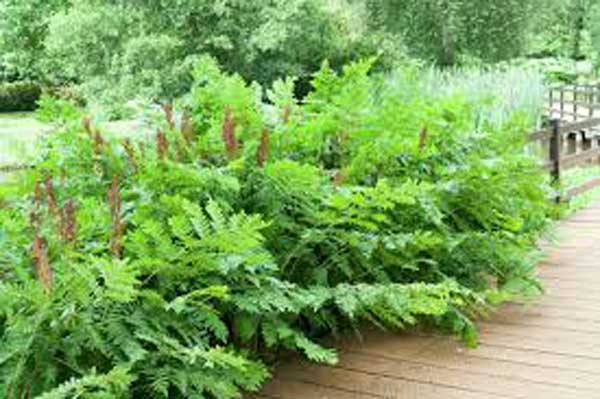

This fern is found naturally in the Caucasus and North America. The plant reaches a height of about 60 - 70 cm. It has beautiful dense bright green leaves. Grows slowly, forms spores. Chistous dignified prefers semi-shaded humid places, well protected from the wind. It should be covered in winter.
Japanese Chistous (Osmunda japonica)
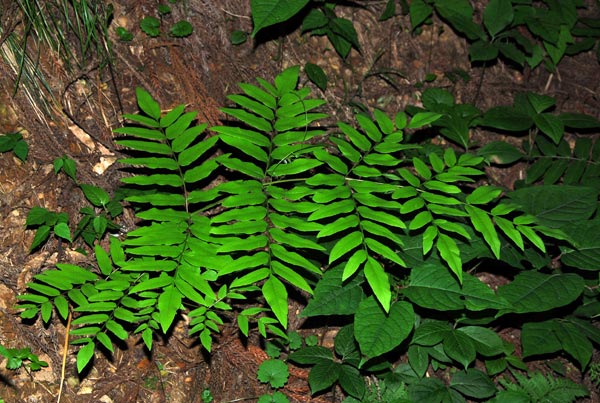

It grows naturally in East Asia. The leaves of this fern species are dense, on rigid, dense petioles, pinnate, with wide lobes. The rhizome is thick, slightly elevated. The plant is grown in shaded areas, in rich loose or rocky soils. Propagated by spores.
Air humidity
Indoor curly ferns love high humidity. Under optimal temperature conditions, the plant will grow well even with a reduced air humidity in the room, which is typical for residential premises during the heating season. If temperatures are above normal or approaching a dangerous border, the green pet should be sprayed more often - ideally every day. To do this, use soft melt or filtered water.
When it gets too hot and the temperature in the room goes off scale, the fern needs to find a new place, where it will be covered with deep shadow.
To maintain optimal humidity, the pot is often placed in a wide tray, which is covered with drainage (expanded clay) or rolled with moss around the edges. Such a filler, sprinkled with water, evaporates the moisture necessary for the plant for a long time.
In cold temperatures and high humidity, the fern can infect the fungus, so this is a poor combination of factors to avoid.
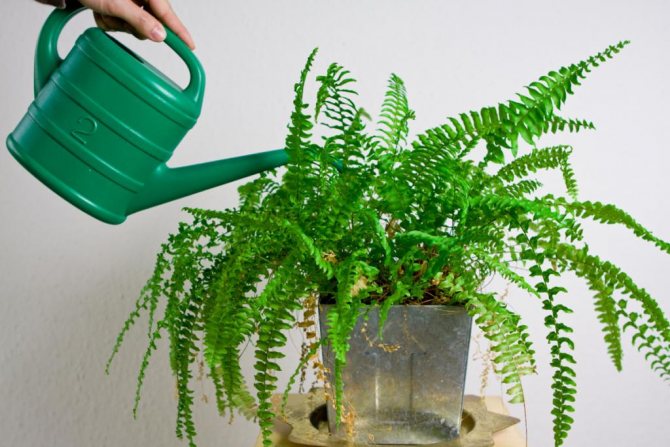

Davallia
Davallia (Davallia) is another unpretentious epiphyte that was able to adapt to indoor conditions. The main habitats of the Davalliev family ferns are the tropics of Asia, Polynesia, the Canary Islands and the island of Java. The peculiarity of davallia is openwork greenery. Moreover, on the old, lower fronds, it has a yellowish tint, while the young growths appearing from the center dazzle with their bright greenery.
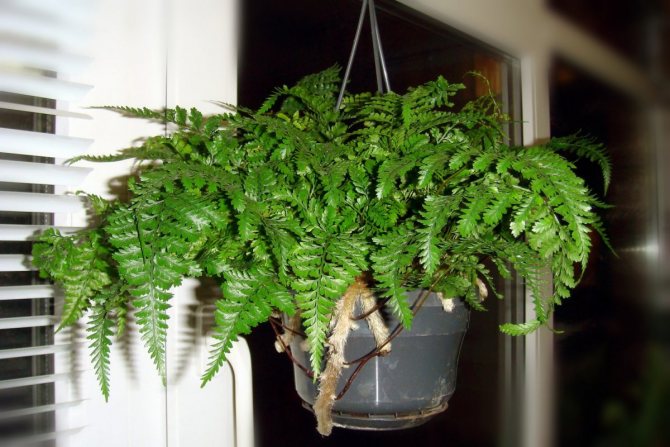

Davallia.
The superficial roots of davallia, growing quickly, creep out of the pot, giving the plant a very exotic look. In no case should you cut off these roots - the plant may not survive this. Due to the shaggy roots hanging from the pot, dawallia is also called "squirrel feet" or "hare feet".
Long curved fronds allow dawallia to be used as an ampelous plant. In a suspended planter in good light, the plant grows well and looks very attractive. The living conditions are the same as for other ferns, with the only difference that high humidity is needed not only for greenery, but also for aerial roots. Therefore, it is recommended to spray the plant from “head to toe”.
Dawallia multiplies by dividing the bush and the best time for this is spring.
Read more about the types and features of growing davallia in the article Davallia - a hare's foot.
Tending the plant at home
By caring for domestic ferns, they create a climate very similar to the natural one. This is required by:
- medium temperature;
- moisture around the environment;
- the presence of light;
- the frequency and extent of humidification;
- the presence of fertilizers;
- transplantation.
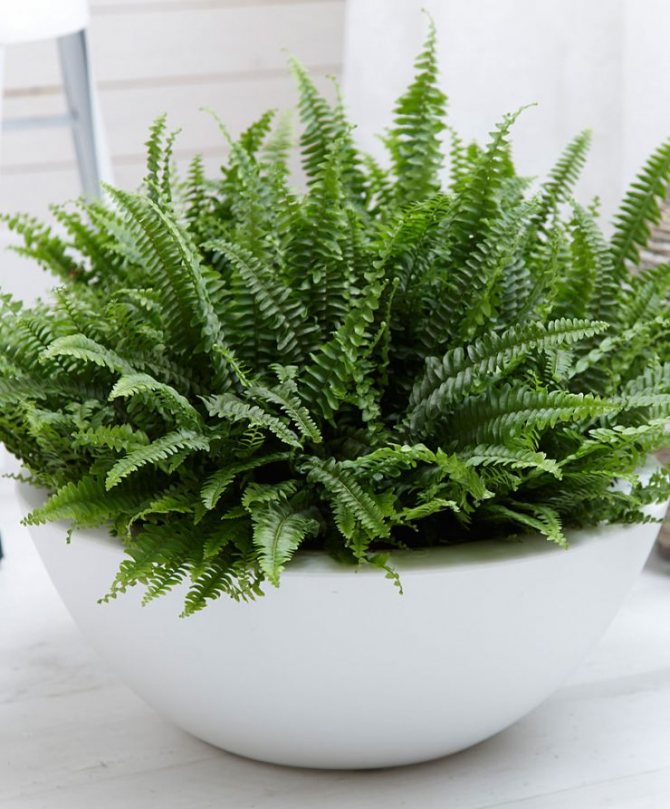

The bulk of the bred ferns, as in the photo, are immigrants from hot places or subtropical areas of the planet. Although there are native inhabitants of zones with mild conditions. They must be protected from wind, sudden temperature changes, hot sun.
Exotic fern species
Due to the large number and diversity of ferns, many exotic, unusual species of this culture have become known:
- Nippon kochedzhnik, known for the unusual color of the wai.
Varieties:
- Pictum - purple branches
- Silver falls - silvery color;
- Ursulas red - purple fern.
- Platycerium (Deer Horn, Flat Horn). A very unusual look, the Vayi really resemble deer antlers in shape, which is why they began to call him that.
Interesting! Thanks to the original and unique shape, colorful colors, ease of care, ferns have won the love and respect of many flower growers. They are able to add variety and beautify any landscape.
How indoor fern reproduces
The simplest method for propagating indoor fern in a pot is to divide the bush. Usually, this procedure is performed in parallel with the culture transfer. After removing the fern from the pot, you can immediately see the small root rosettes-babies. These specimens are carefully separated from the mother bush, and then planted in separate containers or miniature greenhouses.
A prerequisite is the presence of a cover on the seated containers. Transparent or glass caps are perfect for this. During the cultivation of such units, it is very important that the optimum temperature is constantly maintained, and that there are no drafts.
Whichever potted indoor fern you choose, providing it with proper care, you can enjoy the exotic plant right at home. Such crops guarantee a beautiful appearance and effective indoor air purification.
Fern watering
The frequency and intensity of irrigation changes depending on the season. When an indoor flower grows, it is watered more, a decrease in the rate of rise will give a sign of the need to saturate the earth with water less often.
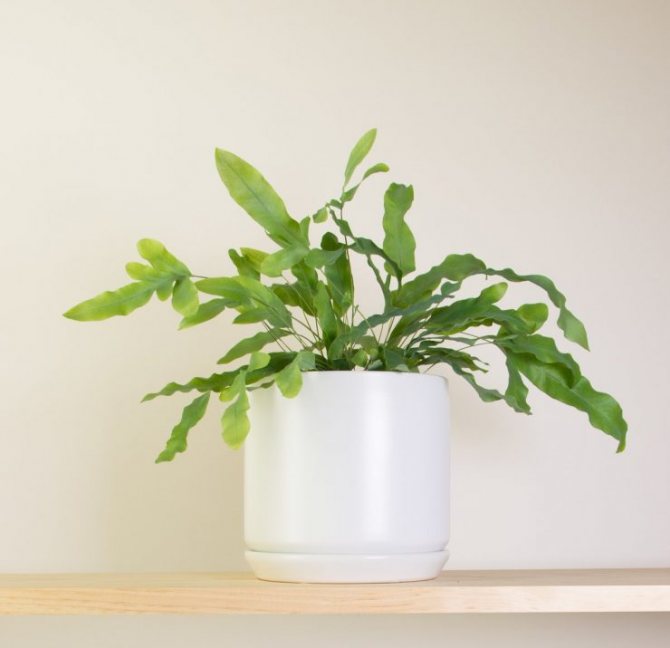

For them, both excess and insufficient moisture are harmful. The first option threatens the thickening and acidification of the soil, a decrease in the saturation of respiration and feeding of the plant. The plant becomes weak.
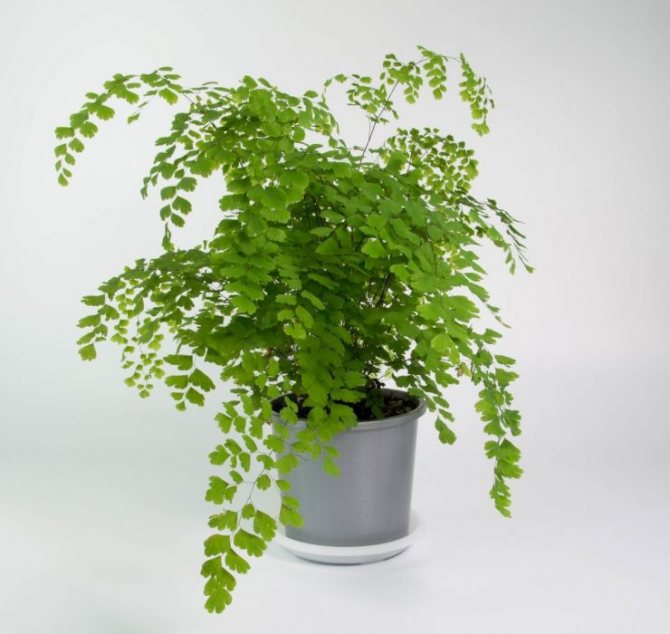

The lifelessness of the base leads to the death of the foliage. Do not think that the plant will recover as a result of watering.
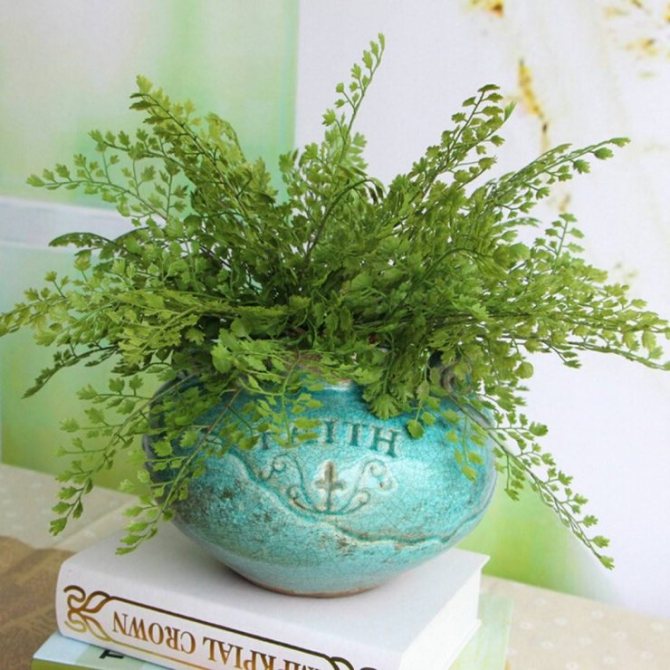

The plant is now removed from lifeless, as well as preserved greenish fronds, after which the pot is placed on a well-lit window.
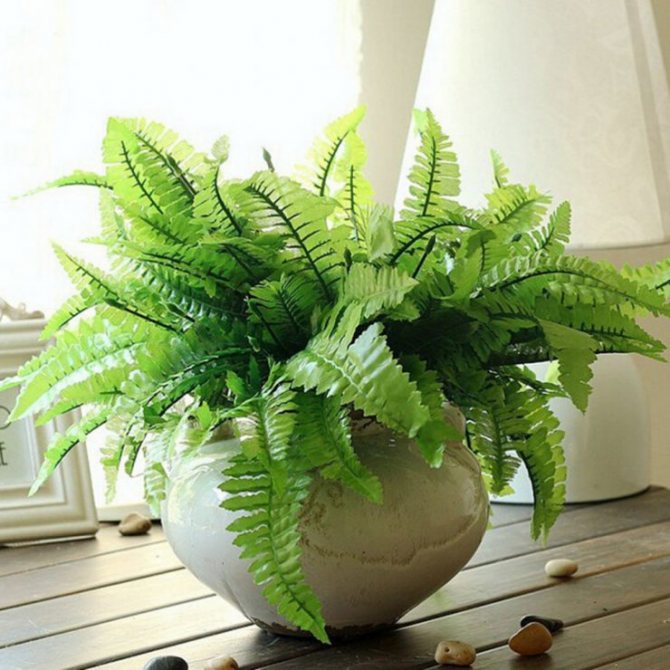

With constant, although not very rich watering, the fern can soon revive. And the indicator of revival will be the elastic greenish springs of fresh foliage formed above the base.
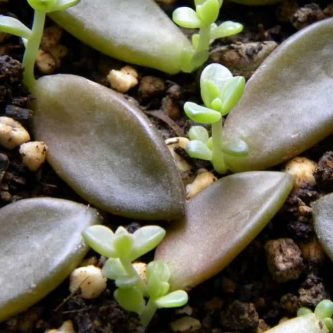

How to properly care for a money tree: transplantation, reproduction, circumcision, disease. 30+ photos, signs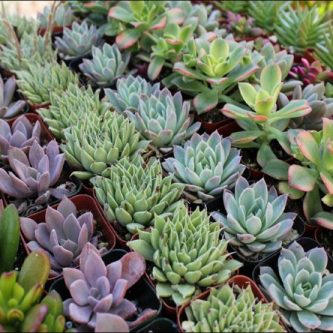

Echeveria - how to care for indoor succulent plants? Watering and soil selection features (55 photos + video)
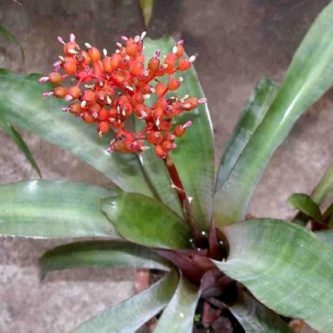

Ehmeya: indoor ornamental flowering plant. Nursing feeding and reproduction (54 photos)
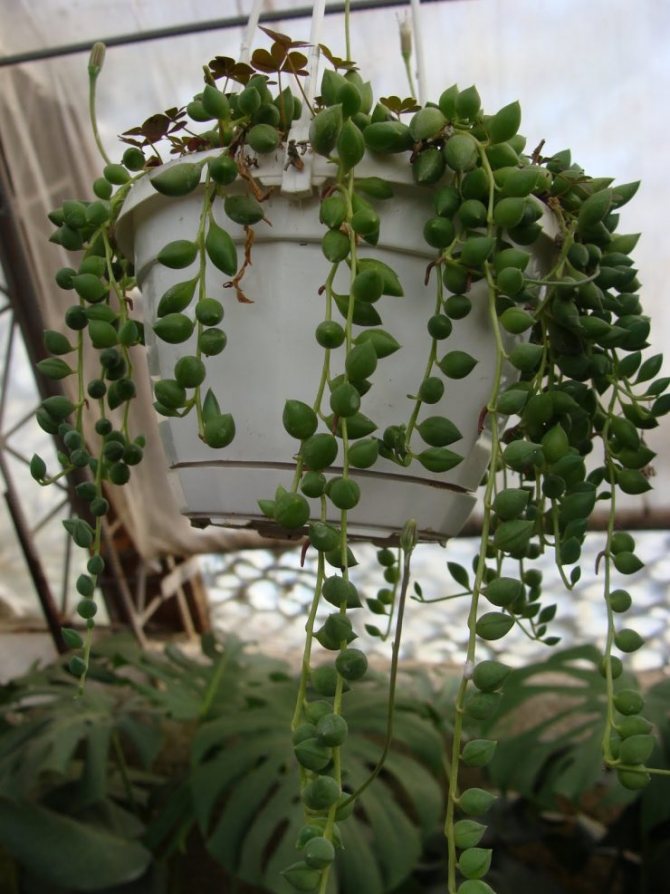

Maidenhair
Maidenhair, or Curly Fern (Adiantum) - one of 200 representatives of the Adiantum family. In nature, certain types of maidenhair are found in East Asia and South America, and in each of these two zones, their own centers of species identity are formed. Some varieties of this graceful fern can be grown indoors.
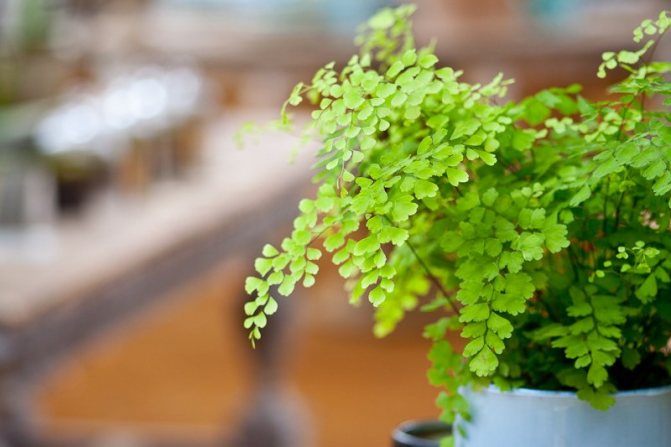

Maidenhair, or Curly Fern (Adiantum).
Maidenhair Venus hair - perhaps the most graceful of all indoor ferns, but also the most capricious. Long fronds of this plant look like brown thin threads, studded with delicate small leaves of pale green color. Sori located on the lower side - spore-bearing areas - shine through the plates of the segments.
In nature, the maidenhair chooses secluded places for itself in crevices of rocks, among stony placers, near streams and lakes. The main thing for him is that there is shade and moisture.If it is possible to create similar conditions in the room, then there will be no problems with growing the maidenhair.
The plant is propagated, usually by dividing the rhizome or a piece of root with 2 to 3 buds. To grow Venus hair from spores, you will need a small greenhouse with constantly moist and warm air.
Many years ago, while working in a greenhouse, I tried to grow maidenhair from disputes, but all my attempts ended in nothing - the disputes stubbornly did not want to germinate. Pots with mother plants were on our floor, in the darkest corner, as far as the term "dark" is appropriate for a sunny greenhouse.
And what was my surprise when one of the days I saw that the green grass, making its way between the slabs on the floor, are small sprouts of the maidenhair. Dampness and concrete slabs turned out to be better for them than any greenhouse. So she planted them later - separated them with a fork and into a pot.
Read more about the types and cultivation of maidenhair in the article Openwork maidenhair - a popular indoor fern.
Some tips for caring for indoor fern
- Humidity. Only water the fern when the top of the soil is slightly dry. You can also place your pot on a tray or saucer filled with pebbles by filling the tray with water. The water will evaporate and increase the humidity around the fern. Spray the fern with a spray bottle filled with warm water. Try to spray the air over the fern and let the fog settle onto the leaves rather than spraying the leaves directly.
- Temperature. Most indoor fern species are tropical species, although not all require tropical conditions. Make sure the temperature in your room where the fern is kept is around 21 ° C. They will not thrive in cold temperatures.
- Shine. Ferns usually prefer indirect light; direct sunlight will burn their leaves. Adjust the blinds to dim the light or move the fern away from the window. The ideal option would be to place the plant near a north-facing window. The east and west windows let in too much direct sunlight.
- Pests. If you find pests such as whiteflies or aphids in the room, gently rinse the branches with water or spray them with a natural indoor plant insecticide.
- Removing diseased fern leaves. If your plant is infested with a disease, cut off the damaged areas. If your fern starts to die as a result of oversight, do the same, removing the damaged or dead part with scissors.
Beneficial features
Different types of curly fern are used for landscaping premises. This is a rather unpretentious plant that grows well in warm and bright apartments and offices. In addition to the pleasure that the sight of lush green leaves brings, fern has health benefits. It cleans the air well, absorbing harmful toluene and formaldehyde from the atmosphere, which is especially important for rooms with high traffic - classrooms, offices, halls in commercial buildings.
It is also believed that indoor curly fern neutralizes various microbes - pathogens. These useful qualities only add to its attractiveness in the eyes of all lovers of home floriculture.
Curly fern
This is the name for any kind of nephrolepis with curled leaves or feathers with wavy edges. Another popular name is curly fern. All of these varieties are derived from sublime nephrolepis. The most popular varieties for home breeding are:
- Hillsii - with double pinnate leaves.
- Superbissima - Feathers split three times.
- Smithii - with leaves cut four times.
- Teddy Junior - wavy leaves.
- Scottii - with curled edges on some leaves.
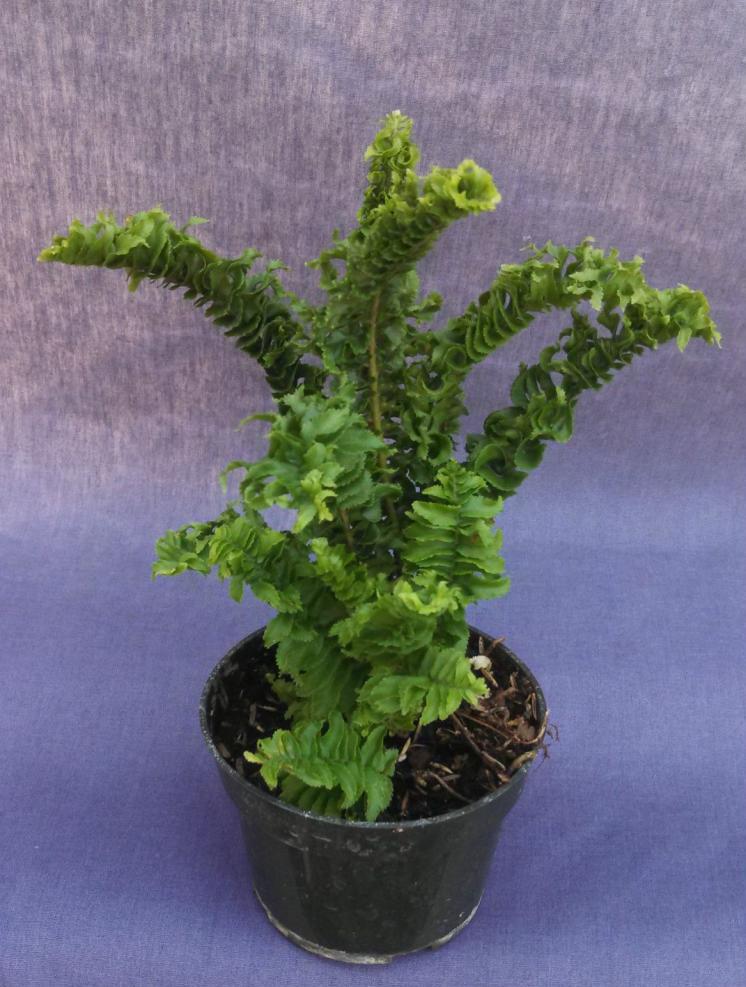

Indoor fern varieties: photos, names and descriptions of domestic varieties
The following is a list of the most popular indoor fern flower varieties derived from the maidenhair species.
"Fritz Luthii" - a flower with a triangular leaf shape up to 30 cm long. The crown is quite lush, but not very dense.
"Fragrans" - the plant of this variety is a lush bush, on each branch of which many leaves grow.
Fragrantissima - a large variety with a crown diameter of up to 1.5 m. The leaves are wide and spreading with a pointed end.
The cultivation of indoor fern varieties of the nephrolepis species is no less common.
"Cordifolia" Is a very compact variety with a rather lush crown. Rounded leaves are located along the growth axis of the flower.
"Exaltata" - this specimen is grown as an ampelous plant. The length of the leaves reaches 1 m. The bush is quite lush and spreading.
"Bostoniensis" - this variety has a curly or corrugated leaf shape, due to which it looks very unusual. It is a dense bush up to 0.5 m wide. The crown is dense and very lush.
One of the most common species in home growing is the pteris. This unpretentious variety will be a bright decoration for any interior. Some of its varieties are described below.
"Cretica" - a small bush with a diameter of up to 40 cm. Vayi, strongly elongated, on a thin petiole.
"Alexandrae" - this variety has an unusual color - the main veins of the leaf are painted in a cream shade.
Ensiformis victoriae - grows in the form of a small green-silver bush. The structure of the plant resembles that of a spruce cone.
Here you can see a photo of these fern varieties:
The following are guidelines for caring for these plants.
Flower propagation
Everyone knows ethnic fables about the fern flower that brings wealth and fortune. It is possible to find such an amazing plant only during one night a year during its flowering.
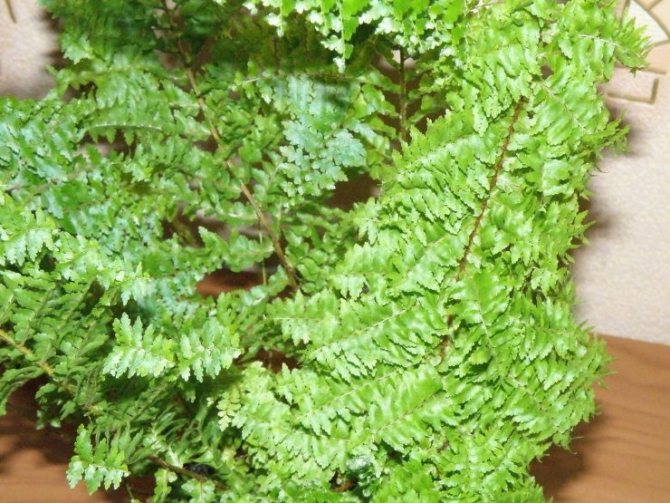

Despite the fact that the characters of fairy tales managed to find a wonderful flower, in reality it is impossible to do it!


At home, this method is quite complicated due to the long appearance of plant embryos. When rare species appear, reproduction by spores cannot be canceled.
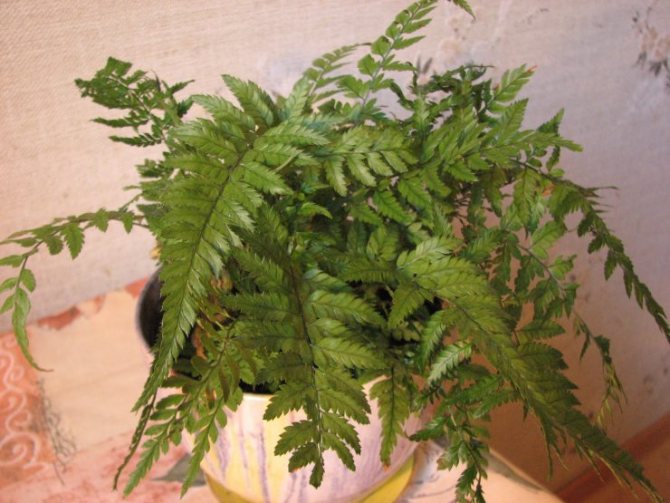

There are a large number of methods for increasing ferns. Some types can be easily propagated by crushing underground parts. Others provide an increment on a particular mustache.
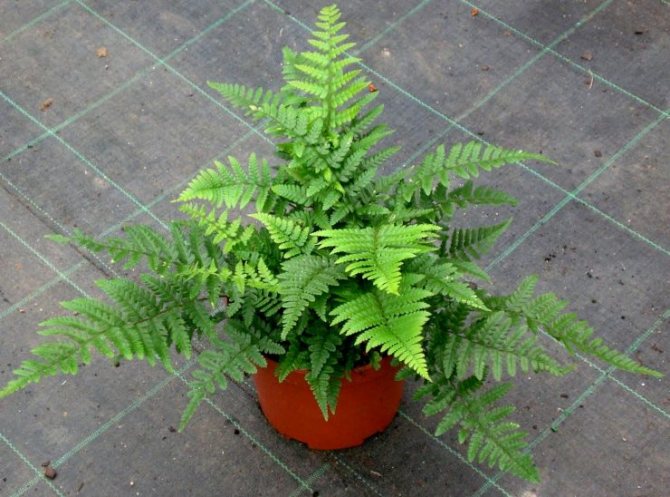

And some, to accelerate growth and provide their own offspring with more opportunities for survival, became viviparous. Generated rosettes appear directly on the vayas. After the buds grow, they crumble and take root.
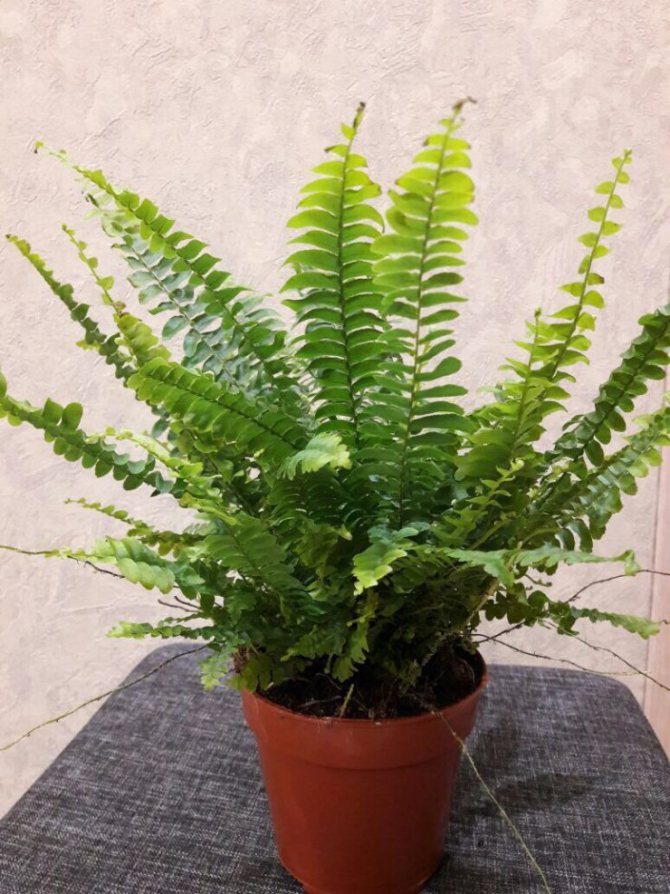

Fern flower - myth or reality?
People do not stop believing in miracles, even if scientists prove that the stated is unreal. The fern flower was of great importance in Slavic mythology, and every year a huge number of people dreamed of finding it. Science has found quite a simple explanation for the "fairy tale". According to legend, the plant glows during flowering, and so scientists say that many fireflies live in humid places where ferns grow. In addition, some plants in the forest produce toxic fumes that cause hallucinations, and anything can seem to a person.


General characteristics of ferns
It is known that ferns began their existence as early as 400 million years ago. In those early years, ferns completely filled the terrestrial landscape. Among the most common at that time, chlorophytums were actively growing, a feature of which was the presence of long hanging leaves.
Today, some fern species feel quite comfortable at home. They are not capricious, so caring for this plant does not require special knowledge and skills.
Landing
As with any plant, correct and competent planting is of particular importance in its existence. It would seem that for this insignificant event nothing but land is needed! But this is not the case! Indoor fern needs a voluminous flower pot, specially prepared soil, as well as the presence of drainage.
The actual period for planting a plant is autumn or early spring. If you are buying a plant already in a pot or plastic container, then, upon arrival home, it is very important to transplant it into new soil in the next few days.
To do this, you will need to carefully remove the flower from its old pot. If the earth lump is too large, then it will take a little, break it using the edge of a knife. Usually, you should pay attention to the root system, which branches out over the entire area of the pot. You also need to remove it with great care.
When the plant is ready for planting, a drainage layer of 3-5 centimeters is necessarily lined at the bottom of the pot. To do this, you can use crushed brick, expanded clay or small pebbles. Only after this procedure can you plant a flower.
Remember that it is very important to plant the plant at the level at which it grew before planting (this distance is from 1 to 2.5 centimeters). If it is buried very deeply in the ground, then the fern may never adapt to the new growth conditions.
At the end of planting, the fern must be watered. Then he is placed in a lighted place.
Location and lighting
For indoor fern absolutely any place in the house is suitable. The only exception can be the south side of the windows. This position of the plant is due to the fact that the flower belongs to the species of shade-resistant plants, therefore such conditions of existence will only contribute to its active growth and reproduction.
Preference should be given not to window sills, but to special flower stands that can be easily placed on the floor. In order for the flower to receive the required amount of light, it can be placed near the window.
Do not forget that the fern must be protected from direct sunlight on its leaves. Otherwise, such exposure can cause severe sunburn, which in turn can lead to the death of the flower.
Pot size
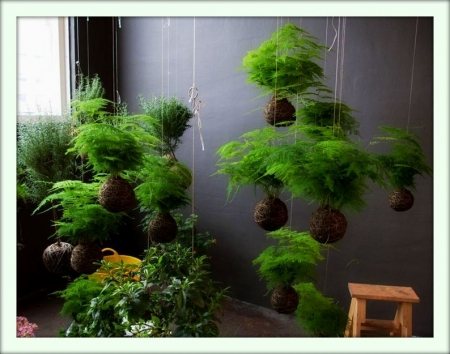

The most suitable pot for indoor fern will be a plastic or clay tank. In order for its root system to be strengthened and at the same time to develop normally, it is very important that during transplantation the pot is purchased 2-3 centimeters more than it was used before.
The diameter of the pot should be approximately equal to its height.
When you buy a pot that is too bulky, you significantly increase the risk that the root system will start to rot. This usually happens in the case of a strong accumulation of liquid after watering.
The soil
Both during planting and during subsequent replanting, the good quality of the soil used is very important. Most often, soil can be purchased at a specialized flower shop. To do this, it is necessary to give preference to the type of soil that is intended for growing ferns at home.
Read also What is the temperature in the cellar in winter and summer
If you wish and have free time, you can prepare the soil for planting / transplanting yourself. To do this, you need to mix sod land with clay, sand and peat. All components must be taken in equal proportions.
The composition of the mixture may vary depending on the plant species.
So, for example, if a flower has a creeping rhizome, then the optimal soil for growing it will be the soil, which is prepared on the basis of coarse sand, peat, soddy earth, leaf, as well as humus.
For a fern with gold or silver foliage, you will need leafy humus, which can be easily obtained in any forest.
Do not forget that the soil, which is prepared by yourself, must be soaked in a weak solution of manganese. This allows you to destroy all insects and flower pests that may be in the ground.
Transfer
The transplant of a young plant is recommended for annual carrying out. For an adult fern, this gap can be increased several times. In this case, special attention must be paid to the condition of the soil and the appearance of the flower.
If you begin to notice the manifestation of alarming symptoms, or the root system begins to grow through the drainage holes in the pot, then this means that the flower needs to be transplanted into a larger pot as soon as possible.
An important condition for any transplant is the presence of a drainage layer at the bottom of the pot. For a fern, expanded clay or crushed brick is well suited. The layer thickness can be from 3 to 5 centimeters.
Keep in mind that the deepening of the leaf outlet into the soil is not made. Otherwise, the fern will not be able to grow further, and after a certain period of time it will simply die.
The top layer of soil is not compacted! Upon completion of the transplant, the plant must be watered and carefully observe the flower for several days. If the leaves do not change their color, this means that the root system has taken root in the new soil and has begun to grow.
Fertilizers and feeding
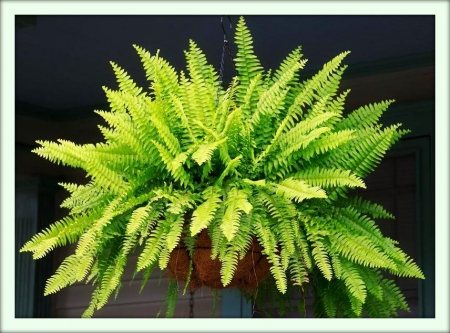

Like many other indoor plants, the fern needs regular feeding. Mineral and potash fertilizers are perfect for this. It is important that the concentration of beneficial trace elements is not too high. Otherwise, the flower growth process can be disrupted.
Top dressing of indoor fern is carried out every 30 days. With the onset of winter, the use of fertilizers must be abandoned!
Watering
To water the indoor fern, you will need to use warm and soft water. It is best if it is preliminarily settled for several days.
In the warm season, the intensity of watering can be at least 3 times in 7 days. In this case, do not flood the flower too much.
With the onset of cold weather, watering is reduced, and is carried out once a week. At this time, it is important to monitor the condition of the soil. It is by no means recommended to allow the soil to become completely dry!
Temperature regime
Most of the entire species of ferns adapt fairly well to temperature conditions, which can range from 15 to 22 degrees Celsius. But among domestic plant species, there are those that need special observance and maintenance of temperature.
- For ferns that love warmth, the indoor temperature should not drop to 18 degrees. These include asplenium, platycerium, and nephrolepis.
- A variety of ferns that are considered resistant to temperature changes should be kept in a room that can reach temperatures up to 12 degrees. These plants include polypodium and pellet.
Air humidity
Indoor fern can thrive in a home with moderate to relatively high humidity levels. The indicator in this case can range from 45 to 65%.
In the presence of dry air, the plant is negatively affected, which can adversely affect the decorative properties of the fern.
In order to avoid unpleasant situations, a regular spraying procedure is necessary.Particular attention should be paid to the flower at the time of strong heating of the house. In this case, spraying can be carried out several times a day.
With the onset of summer, not far from the fern, you can place a small container with liquid, which evaporates and maintains the necessary moisture level for the growth of the flower.
Pruning
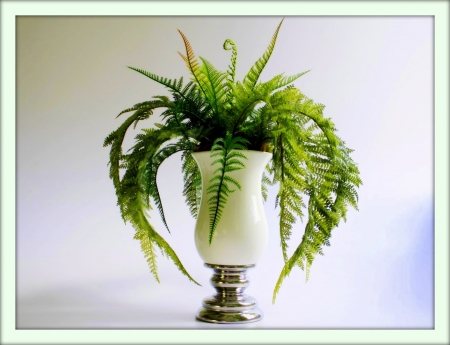

For the fern to grow normally, pruning is essential. Remember that pruning during active plant growth is strictly prohibited! An exception can only be those cases when the flower needs urgent salvation.
If the long fern leaves do not create much discomfort for you, then you do not need to cut them off. It will be enough to twist them together and attach them in another pot with a wire or thread.
In adult plants, pruning of old leaves should be carried out strictly under the base of the flower. At the same time, you need to be as careful as possible so as not to harm the young snail leaves, for which it is almost impossible to restore their normal development.
Indoor fern pruning should be done every 2 years. Each grower makes an independent decision on this matter.
Fern diseases and pests
The fern is considered a fairly resistant plant. But if it is not properly cared for, then the plant becomes vulnerable to many diseases and flower pests.
Most often, the plant dies due to the fact that irregular or abundant watering is carried out.
- So, for example, if you water a fern with cool water, then a nematode will form in the ground over time. In this case, the plant needs urgent transplantation into new soil. If this is not done in a timely manner, then the insect can infect the leaves and shoots of the flower, which will only lead the fern to its rapid death.
- During the transplantation, the Actellik 0.15% solution can be used to treat the plant. It fights very effectively against flower parasites and helps to save the plant from severe damage.
- If the air humidity in the room is at a low level. This will cause the appearance of scale insects, thrips and aphids. To avoid the appearance of these pests, the flower must be regularly sprayed with warm water. In case of severe damage to the plant, it is necessary to use a soap and dinesecticidal agent.
- A change in the color of the leaves of the plant indicates that the fern is exposed to very strong rays of the sun. To cope with this trouble, it is enough to place the flower in a darkened place.
- When the foliage begins to wrinkle and become covered with small spots of a dark color, it is necessary to water more often and more abundantly.
Read also Peony moning lilak description
Bloom
Unfortunately, the fern, as well as the nephrolepis, does not have a pronounced flowering period.
Reproduction
Reproduction of indoor fern takes place in several ways: by spores and by dividing the bush.
Spring is considered the best time for the procedure.
When dividing the plant's shoots, the propagation process is best done during the transplanting of the flower. This will require several long shoots to be connected together and immersed in the soil in another pot. In order to secure them securely, you will have to use wire. As soon as the sprout takes root and begins to take root, it must be carefully separated from the mother part of the flower.
Reproduction by using spores has long been considered effective. It is for this reason that few people use it today. The preference is usually given to the method of dividing the bush. It allows you to achieve much greater and positive results, and besides, it is the most suitable option for breeding at home.
Dormant period
The dormant period for the fern falls from October to February.More often than not, such an atmosphere is created by force. For several months, it is necessary to monitor the maintenance of normal temperature and humidity in the room.
Do not forget that the use of fertilizers and watering during this period is not recommended!
Plant toxicity and beneficial properties
Despite the fact that most of the fern plant species is poisonous, these plants are very widely used for medicinal purposes. Preparations based on them perfectly help to cope with intestinal infection and other ailments that affect the human digestive system.
When taking medications, as well as self-prepared fern broths, it is imperative to consult a doctor!
Indoor fern will be a wonderful decoration in any home. It will help restore a favorable atmosphere and purify the air. With proper care, a flower can delight you with its growth for many years!
Ferns are ancient plants that have been known since the Paleozoic and Mesozoic eras. Since then, they have changed significantly, but their external attractiveness and beauty have remained unchanged. Now crops are planted not only in the garden, but also in a house or apartment. Let's take a look at how to grow indoor potted ferns and which types are best suited for such purposes.
Soil selection
For normal growth, indoor curly ferns need a light soil mixture, rich in nutrients. To do this, you need to mix three components in equal proportions - peat, greenhouse soil (or coniferous soil), and sand.
You can purchase a ready-made fern substrate. It is used both in its original form and enriched with peat and sand. At the bottom of the container, drainage must be laid - expanded clay or small pieces of bark of coniferous trees (mainly pine).
Fern Pellaea (Pellaea)
The fern species Pelley is about 80 species of herbaceous perennial plants, common in temperate, tropical and subtropical regions of both hemispheres, but mainly in America. The name comes from the Latin "pellos" - dark. The plant is named so because of the dark color of the petioles and leaf shafts. Small terrestrial ferns with creeping stems, dense leathery brownish rounded leaf lobes. In room conditions, he prefers a bright, but cool place protected from direct sunlight. In winter, moderate watering is required, as the earthen coma dries out. Propagated by spores and rhizome division.
Pellea spear (Pellaea bastata)
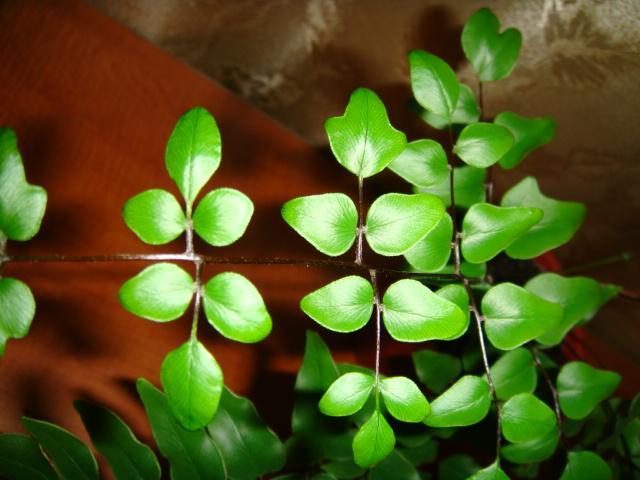

In nature, it grows in Africa, on the island of Madagascar, on the Mascarene Islands.
Pellea spear-shaped is a perennial herb with a creeping stem. The leaves of this fern are double- or triple-feathery, collected in a basal rosette. The leaves are triangular in outline, on red-brown long petioles. Leaves reach 60 cm in length, 30 cm in width. Segments are triangular or broadly lanceolate, unequal, whole-edged. Sporangia are located in a continuous line along the edge of the segments.
Round-leaved pellet (Pellaea rotundifolia)
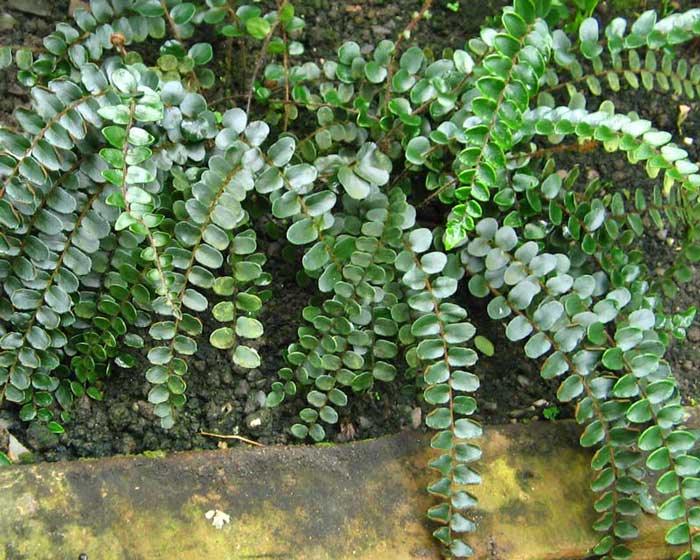

In nature, it is found only in New Zealand, where it grows on stones and rocks.
Leaves are once-feathery, in indoor conditions they reach 20-30 cm in length and 4-5 cm in width. Creeping rhizome, covered with scales.
Segments are round or elliptical, entire, glabrous, leathery, dark green, on short petioles. Sori are covered with folded edges of leaves.
Transfer
Ferns are transplanted in the spring, when the dormant period ends and active growth begins. The rhizomes of these plants are fragile, so they are not cut off, but they are carefully spread out. At the bottom of the container, there must be a layer of expanded clay. The soil is poured so that there is room for watering on top.
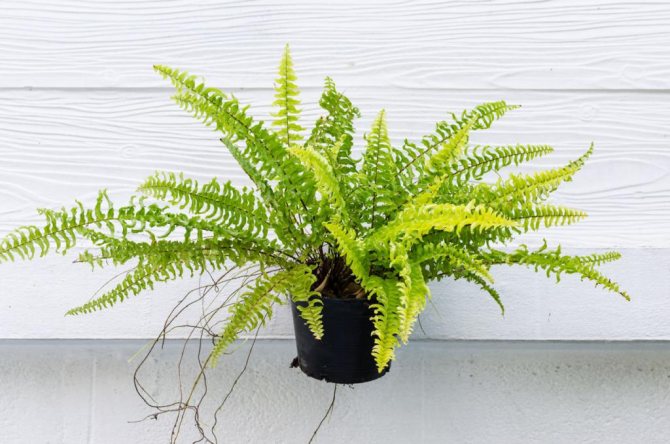

When transplanting, the aerial roots are not cut off.You can carefully remove the slightly damp soil with rhizomes from the container, wrap additional roots around the clod and place the plant in a new container.
Why indoor fern dries
All varieties of indoor fern can suffer from leaf drying problems. This can happen for several reasons:
- Failure to comply with the rules of crop care. Most often this happens in the autumn, spring, when the heating season begins or ends in the house. Due to excessive heat and dry air, the tips of the leaves begin to dry out.
- Improper watering. It is very important that the soil is constantly moistened, but at the same time there is no excess moisture.
- The appearance of pests. For example, scale insects lead to the death and shedding of leaves, so it is necessary to inspect the flowerpot in a timely manner for the presence of parasites.
If insects have caused the leaves to dry, then use toxic insecticides. In case of increased dryness, it is necessary to spray the air with a spray bottle. You can also move the flowerpot away from the heaters if they are too close to them. If there is a shortage of water, the culture will have to be revived. To do this, the flowerpot is immersed in a pot of water, left there until it is completely saturated with water. Thanks to this "bathing", you can significantly improve the condition of the indoor fern.
Photo gallery
Planting a fern in a pot
Edible bracken fern - what it looks like and where it grows
Fern roots grow quickly, and the pot becomes small for them, so the plant needs to be transplanted annually. Stems and leaves are also characterized by intense growth. At the same time, the soil rapidly loses nutrients, which is the second reason for frequent replantations.
Important! If the young sprouts take on a pale color instead of rich greenery, this serves as a signal that the fern should be planted in new soil.
The formed plant stops intensive growth, the frequency of transplanting is reduced to one in 3 years. The optimal time for the procedure is spring, immediately after the rest period.
Most ferns are forest dwellers, which is why they prefer moist, humus-rich soil. The best solution is to purchase a special fern soil. If it is prepared on its own, then it is necessary to mix deciduous compost there, increasing the amount of humus. The soil should be light, airy, and absorb moisture well, but not prevent it from seeping.
To grow a fern, an acidic substrate is used; plants cannot tolerate an alkaline environment. When self-preparing the soil, leaf and sod land is mixed with peat, coarse sand, leaf compost. The prepared substrate is placed in a preheated oven for 1-1.5 hours. This will serve as prophylaxis against pests.
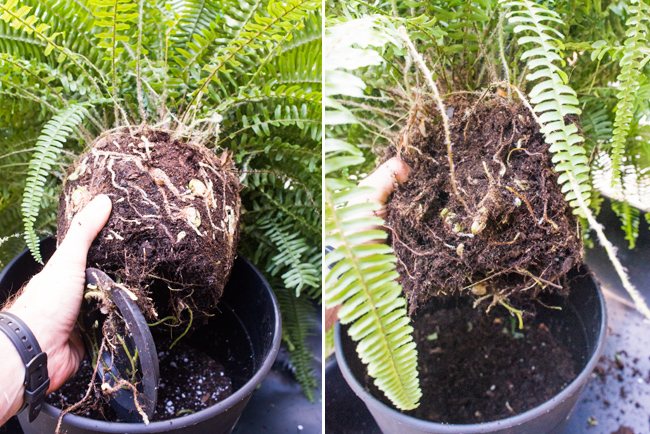

Fern transplant
A good plant pot is heavy, better ceramic, capable of absorbing and releasing moisture. Light containers can tip over when the fern grows asymmetrically.
Transplant stages:
- Immerse the fern directly in the pot in a container filled with water, wait 15-20 minutes, then turn the flower container over and remove the plant with an earthen clod;
Important! If the fern maintains a healthy appearance, the root system also does not contain rotten or dried out areas, the plant can be planted in a new place. If there are rotten or dry roots, they should be cut off, cut with a potassium permanganate solution and sprinkled with charcoal. Then start the planting process.
- Lay a drainage layer at the bottom of the pot (small pebbles, brick chips, etc.);
- The container is filled up to the middle with ready-made soil;
- The plant should be planted carefully, gradually sprinkling it with soil, leaving the root collar free;
- Watering generously after planting is very important. The next irrigation cannot be carried out without waiting for the soil to dry out from above.
After 15 days, when the fern has taken root, care resumes as usual.
What do scientists say?
Probably, as long as people live, as long as the disputes about this mysterious plant will continue. They will also pass on from generation to generation stories about the missing people in the villages, there will also be daredevils who, on the cherished night, will go to the fern thickets for a magic flower. So how do you know if ferns are blooming? You can go to the forest yourself - according to legend, the fern blooms a few minutes before midnight, and at midnight its color, having gained full strength, disappears, as if plucked by an invisible hand. Or trust science. Do ferns bloom? The scientific answer is no. However, it is worth remembering that there are exceptions to everything. The ancestors believed that the fern opens a fiery red bud for hearts in love or for those who are ruled by the thirst for omnipotence. And it seems that scientists out loud say that a spore plant cannot bloom. However, historians to date have proven the existence of Baba Yaga. So maybe the next step is to introduce the fern flower to the world? Who knows ...
Houseplant structure
Ferns are located among the lower plants, as a result, they have the features of the oldest plants of the flora, while they have successfully mastered the criteria that have changed over so many years.
This specificity is undeniable when studying the structure of the fern. The foliage, or rather fronds, represent the upper part of the flower and, for the most part, are distinguished by an interesting and repeatedly cut type.
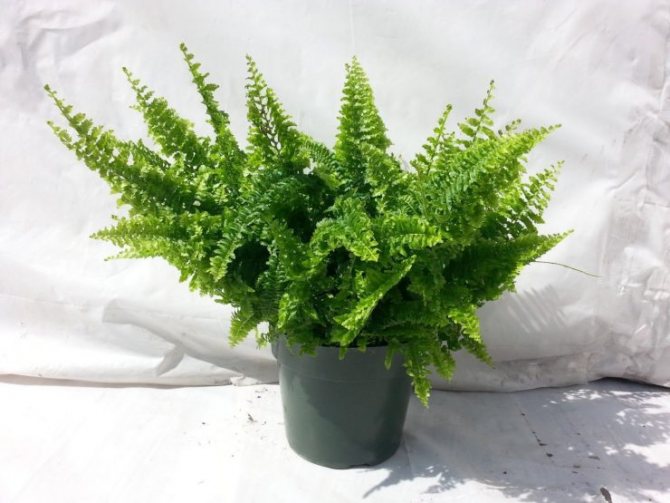

Young, not blossoming deciduous plates of plants are elastically twisted into springs.
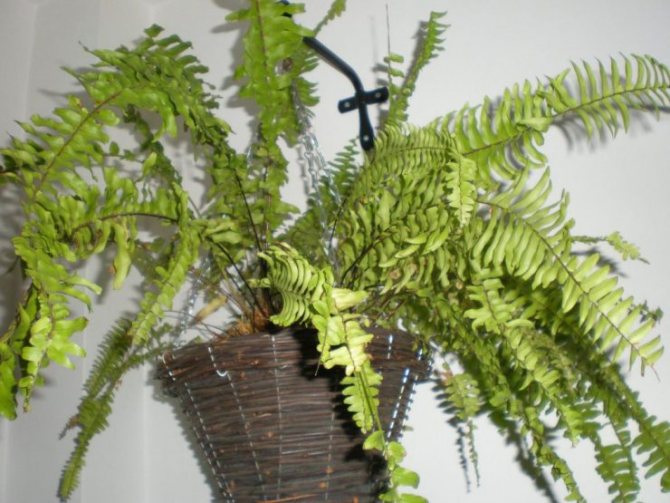

When growing, they bloom, darken and thicken. The roots of the plant are located underground.
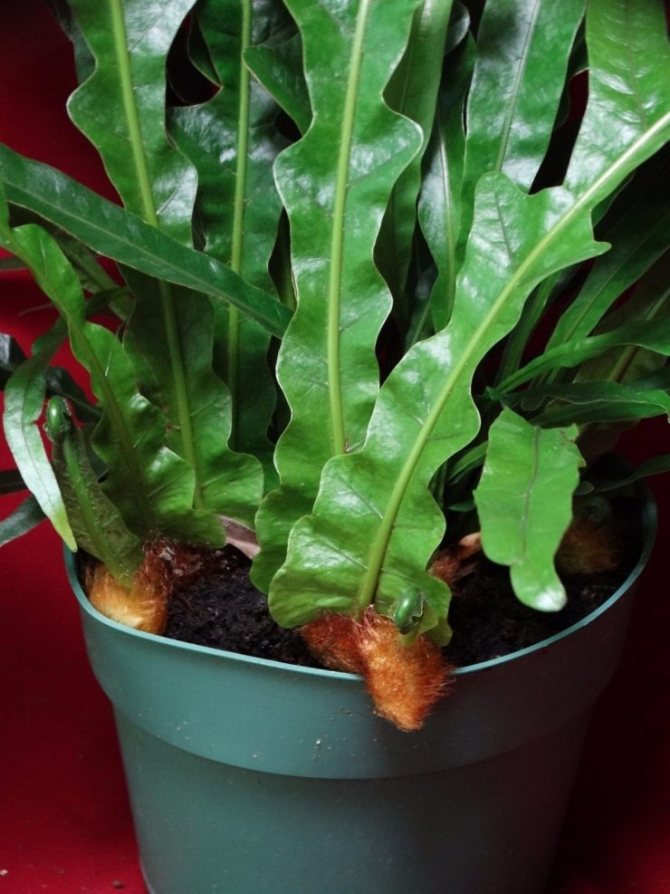

Major diseases and pests
Usually, the plant begins to hurt, or is exposed to an invasion of pests, if it is constantly looked after incorrectly.
If a fern is watered with unsettled water, in which there is a large content of chlorine, or if it is cold, then a nematode may attack it. At the same time, the foliage begins to turn yellow and fall off. Usually the only salvation is an urgent bush transplant. When transplanting, the fern must be treated with insecticides.
If the humidity in the room is low, then pests such as scale insects, aphids or thrips can attack the fern. You should spray the plants every day to avoid this. If insects do appear on the foliage, then the fern should be treated with special preparations.
About ferns
Under natural conditions, the plant grows in the tropical zone of America, Australia and Asia. Although its northern varieties are also widespread. It is a herbaceous perennial with short and short roots and large panicles of pinnate leaves. On the back of the leaves, in small brown projections, there are spores. Also, ferns often release tendrils on which new young plants begin to grow.


Fern-like flowers
There are many plants that resemble ferns in leaf shape:
- Biophytum. Ornamental compact plant in the form of a palm tree;
- Zamia. A compact flower with a dense trunk and feathery oval dark green leaves;
- Eschinanthus. Ampel plant, valued for beautiful flowers, rather difficult to care for;
Eschinanthus
- Tsikas. Sago palm, unpretentious in care;
- Palm-shaped encephalyartosis;
- Grevillea. Hardy ornamental plant with fern-like leaves;
- Hamedorea. Bamboo palm, loves moisture and warmth.
Pteris
The numerous pteris family presented their representative to indoor floriculture - Pteris (Pteris). Ferns of this species are widespread everywhere - where there are tropics or subtropics, there is also pteris. In indoor floriculture, several types of pteris are common, but they are all quite unpretentious.
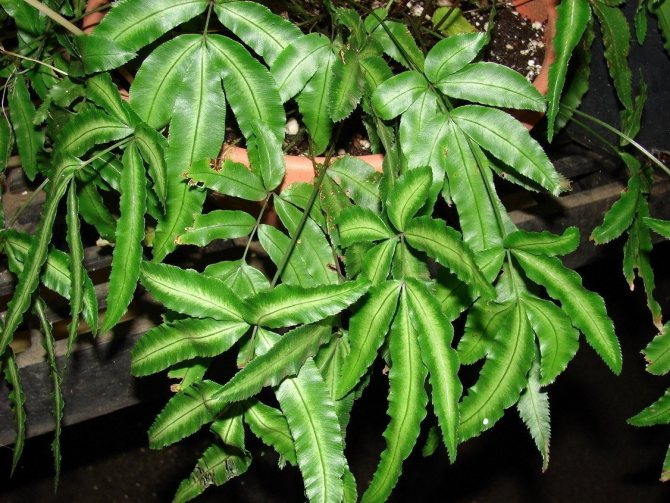

Pteris (Pteris).
Cretan pteris - the owner of beautiful feathery leaves up to 50 cm long. The segments are arranged in pairs from 2 to 6 and have a beautiful color - the center of the plate is bluish-green with a dark border along the edges.
Pteris xiphoid outwardly a little similar to the Cretan pteris, but its color is somewhat darker, and the leaf segments have jagged edges.
All types of pteris prefer high air humidity, well-lit location, but not exposed to sunlight. They grow well at a moderate temperature not exceeding 22 ° C. In winter, a period of rest is necessary with a decrease in temperature to 17-18 ° C. Lower temperatures are undesirable, although hardy pteris can withstand short-term cooling up to 10 ° C.
Pteris reproduces, like most ferns, by spores and division of the bush.
Read more about the types of pteris and about caring for him in indoor conditions in the material Pteris - the most unpretentious of the ferns.
What to do with a fern flower?
It remains to figure out what to do with the flower in order to get its energy. The best solution is to dry the bud to prevent spoilage. You can also put a flower in a bag. As a result, you will get a powerful amulet that you need to constantly carry with you. The fern flower is a symbol that attracts happiness, gives the ability to see treasures and protects from any evil spirits. In addition, it is considered a powerful love magnet and with its help you can attract any person to you. The fern flower is a Slavic symbol of good luck, and there is also an opinion that it gives strength to understand the language of flora and fauna.
Characteristics of fern species
| Type name | Characteristics |
| Maidenhair Radi | Graceful foliage, good branching, dark petioles |
| Maidenhair finely pubescent | The foliage is forked at the base, the young leaves are pinkish brown |
| Maidenhair Venus hair | Its thin petioles are similar to hair, their color is light brown, foliage is rounded, small, bright emerald |
| Asplenium nesting | It grows well in partial shade, requires high air humidity, the foliage has the shape of a gladiator's sword, a vein of a darker shade runs in the center of the leaf, the edges are slightly wavy, they can stretch up to 0.6 m in length |
| Asplenium bulbiferous | The petioles of the plant resemble wires in their appearance, they are of a dark shade, the foliage is feathery with a rich emerald color |
| Aglaomorph Meyen | The rhizome of this fern is shaggy and creeping. On the aerial part of the flower, there are both wide and narrow foliage. |
| Blehnum humpbacked | The crown of this fern can grow up to a meter wide. Therefore, a spacious room is needed for him. The foliage is tough, the main trunk is well developed in an adult plant |
| Cytobotium Shide | The stems of this species can reach a height of 2.4 m.The foliage is arched, curved, carved, of a pale emerald hue |
| Cyrtomium crescent | The species is not afraid of drought and drafts. The leaves are elongated, carved at the edges, their color is dark emerald |
| Davallia | The foliage of this fern is similar to the tops of a carrot, and the rhizome is usually taken out from the soil of the pot. |
| Dixonia protruding | This species requires a lot of free space, since an adult plant can reach a height of 5 - 6 meters. Its foliage is leathery, faded green. Barrel - powerful, dark brown |
| Didimohlena slightly truncated | Grows well in the shade. The foliage is shiny, leathery, small, truncated, green with a brown tint. |
| Sublime nephrolepsis | Grows well in the shade, but requires regular watering and high humidity. Foliage is arranged vertically, its edges are even. Stems are long and thin, covered with thin scales. |
| Nephrolepis cordifolia | Foliage can stretch up to 0.6 m in length. |
| Round-leaved pellet | The plant stretches up to 0.3 m in height, the rhizomes are small. The foliage is rounded, leathery. |

